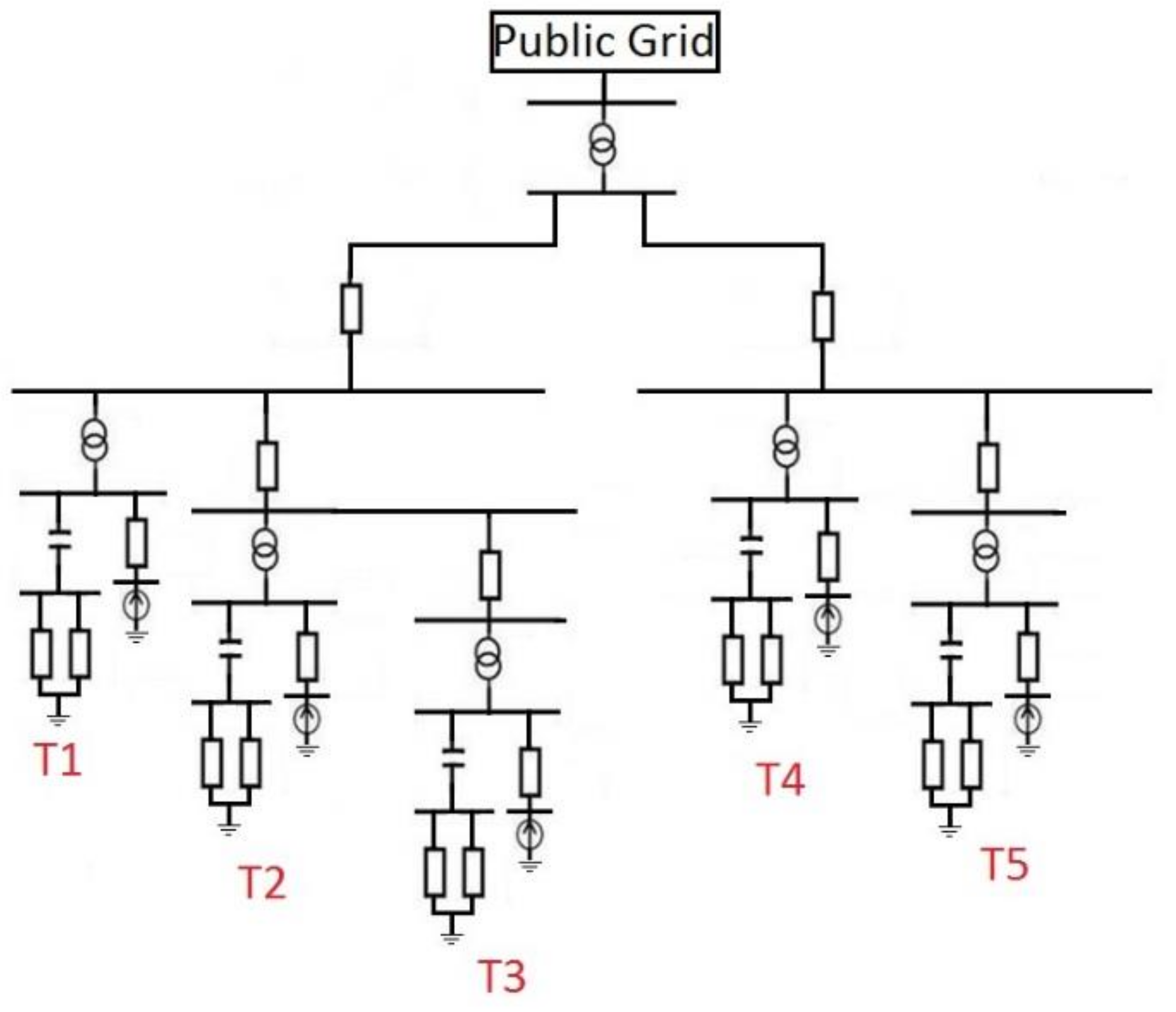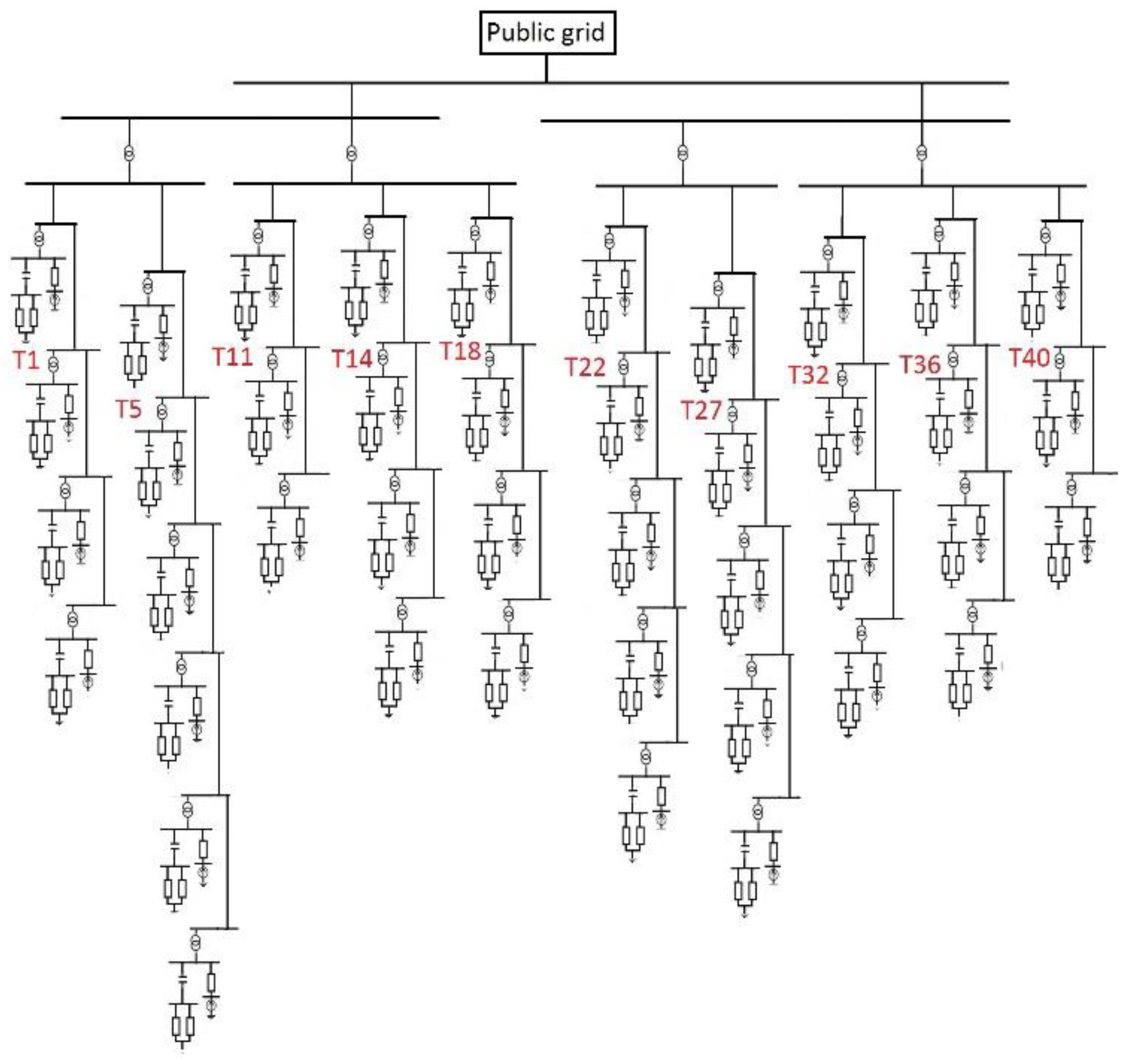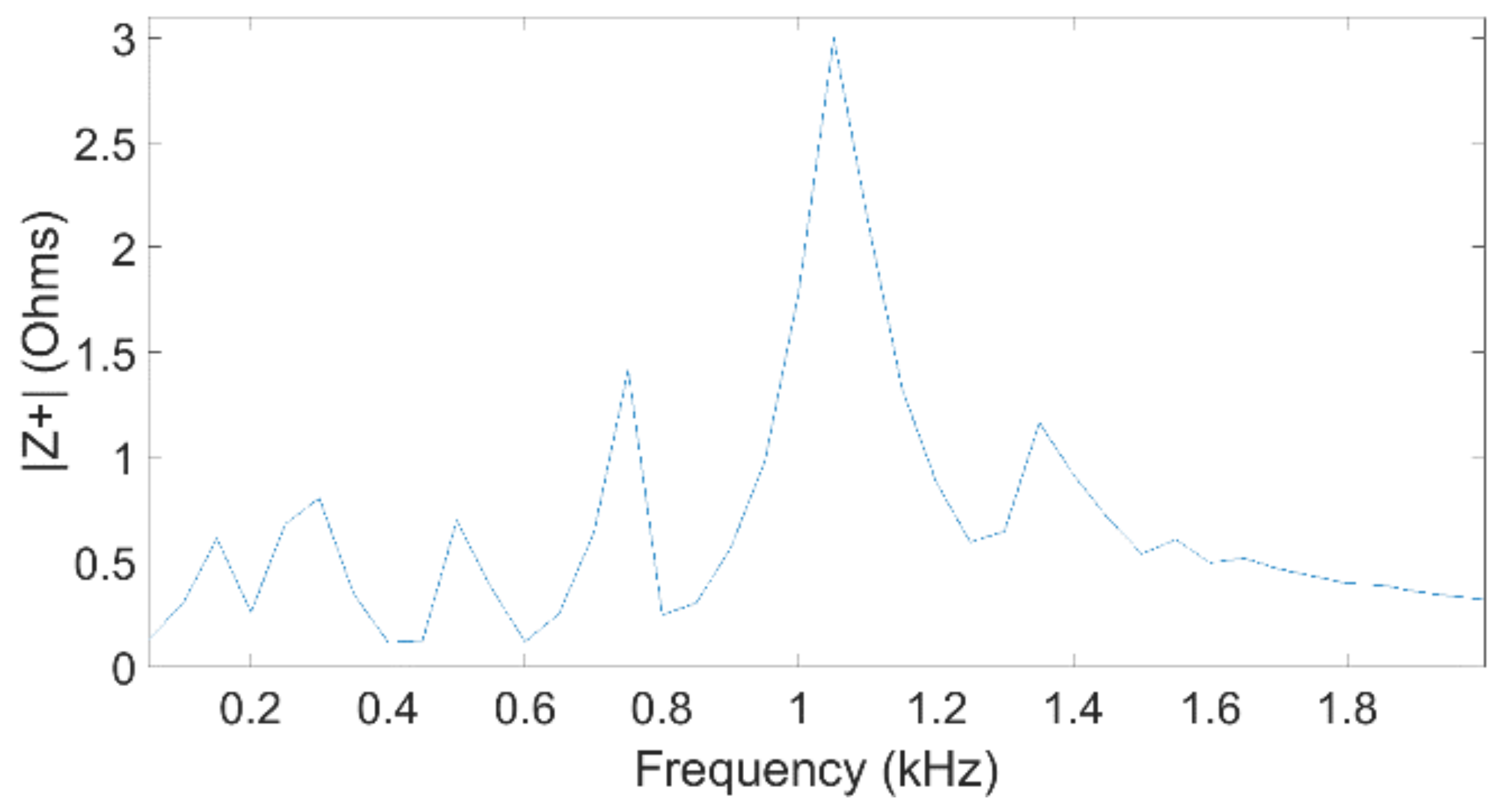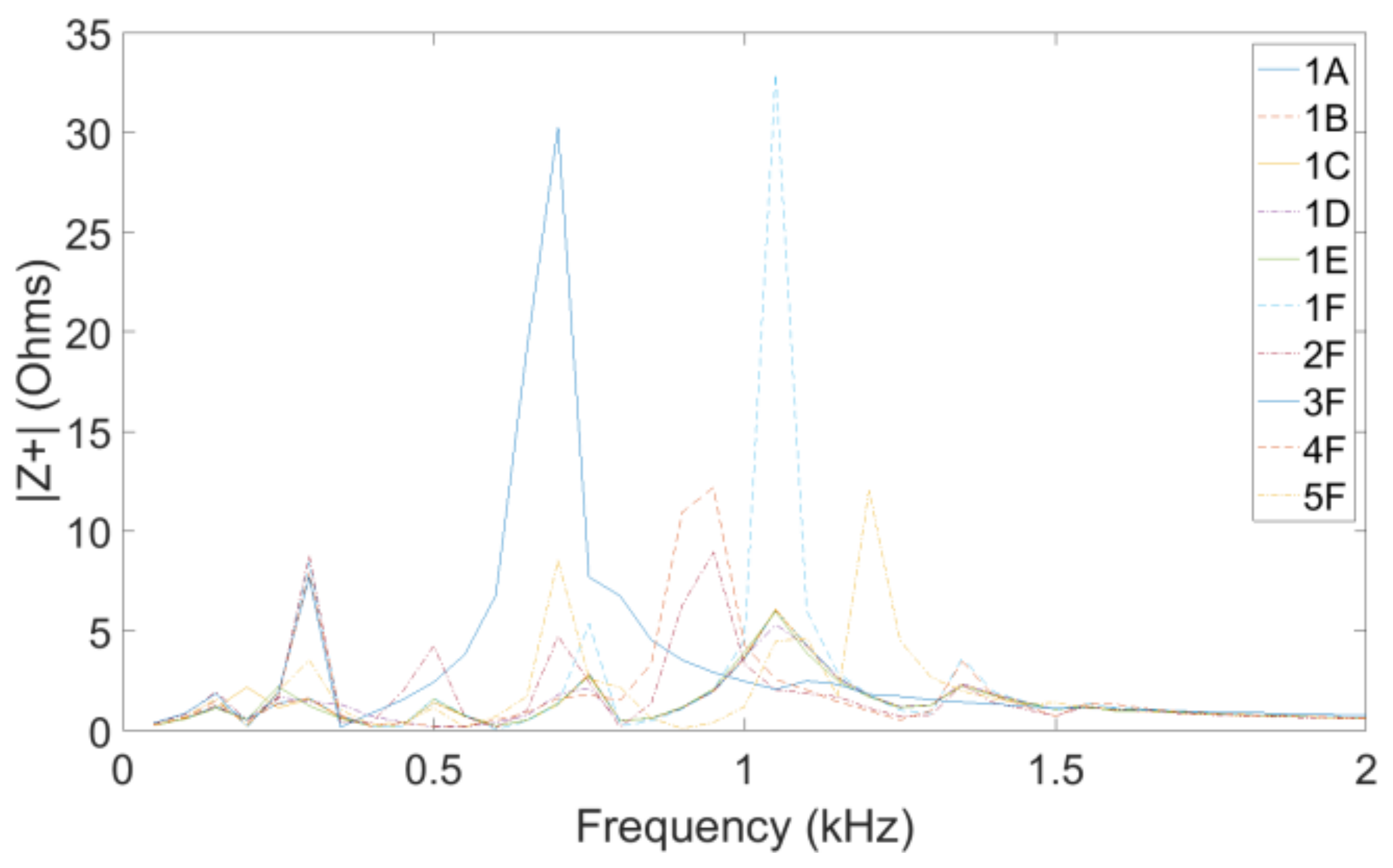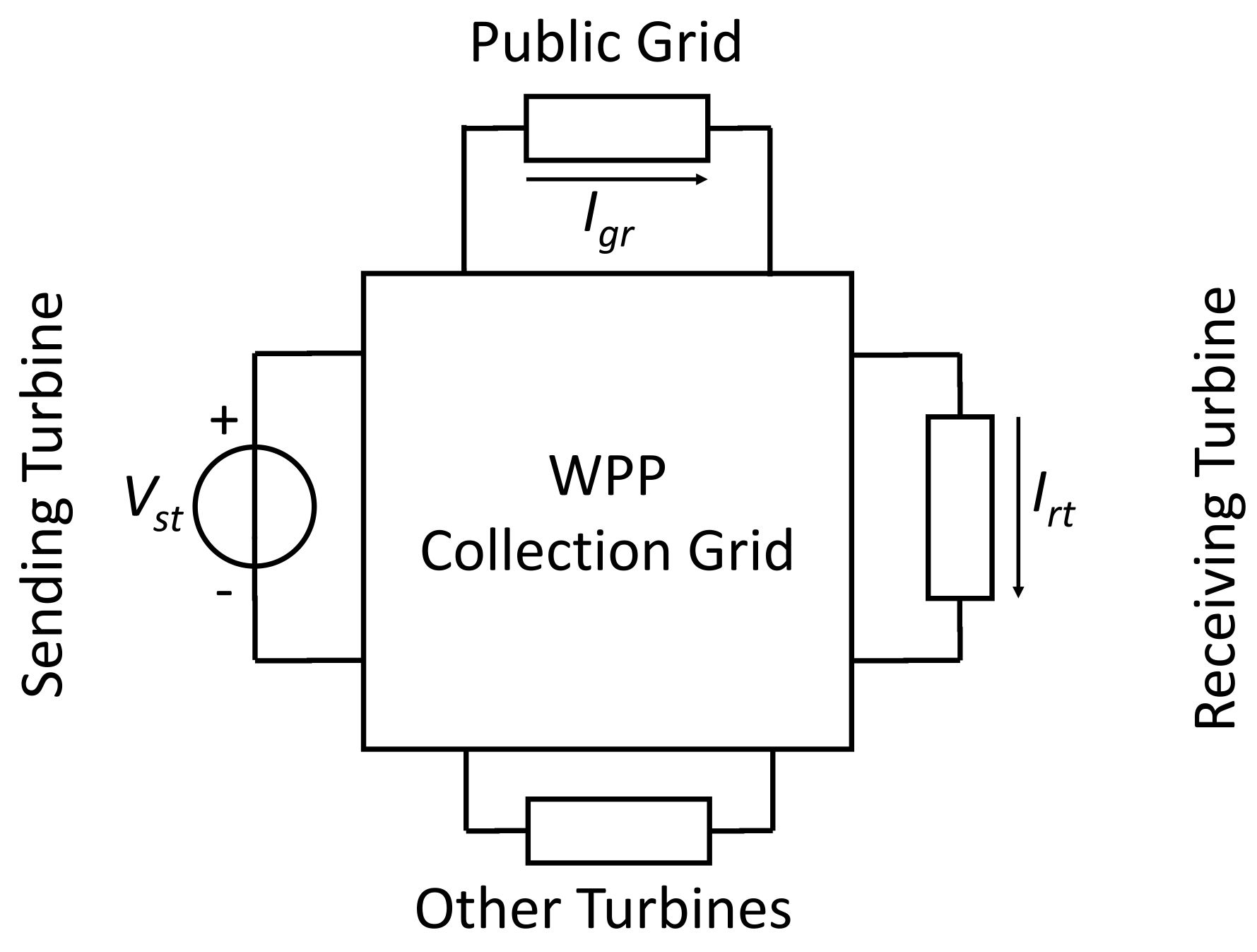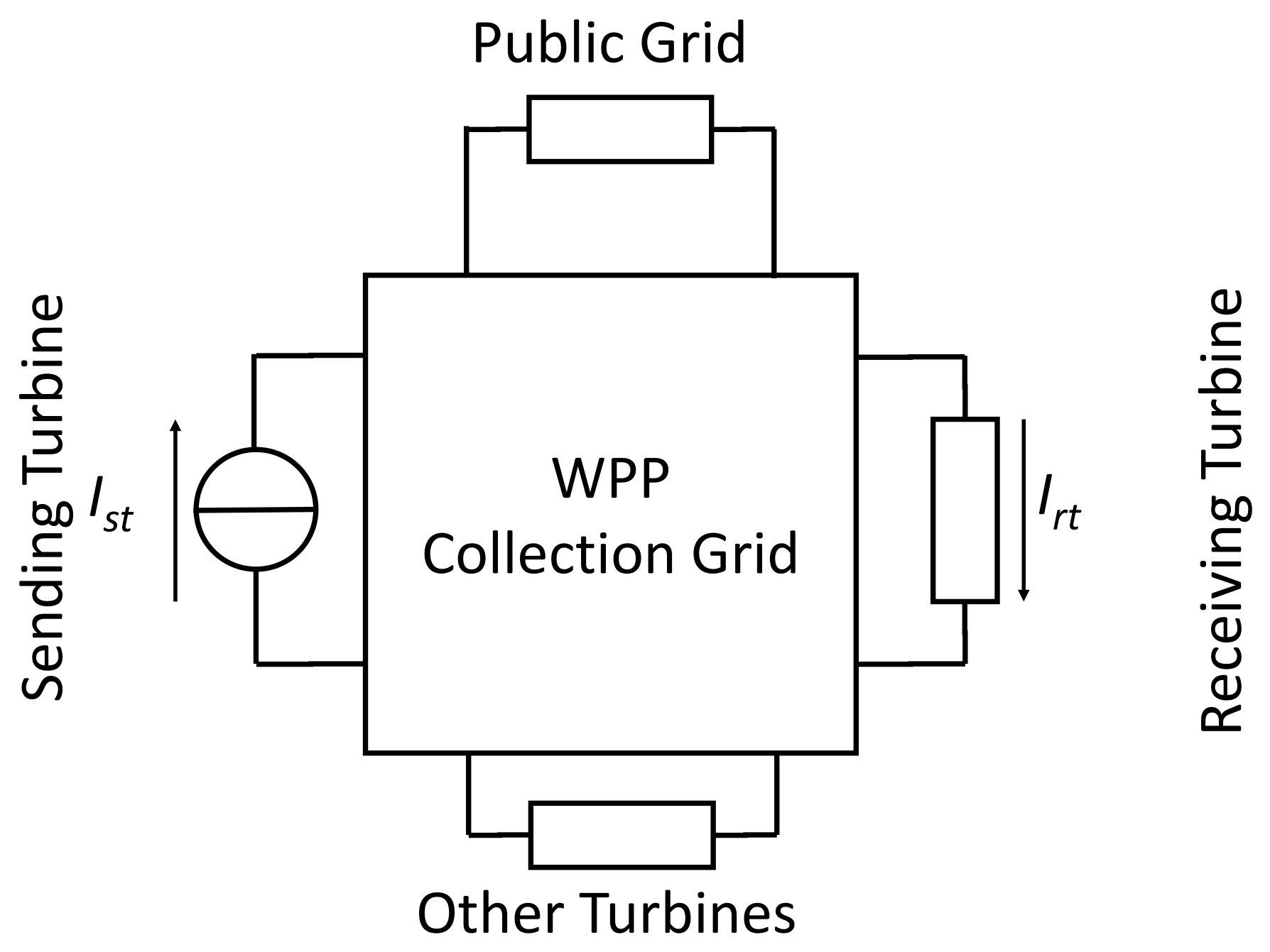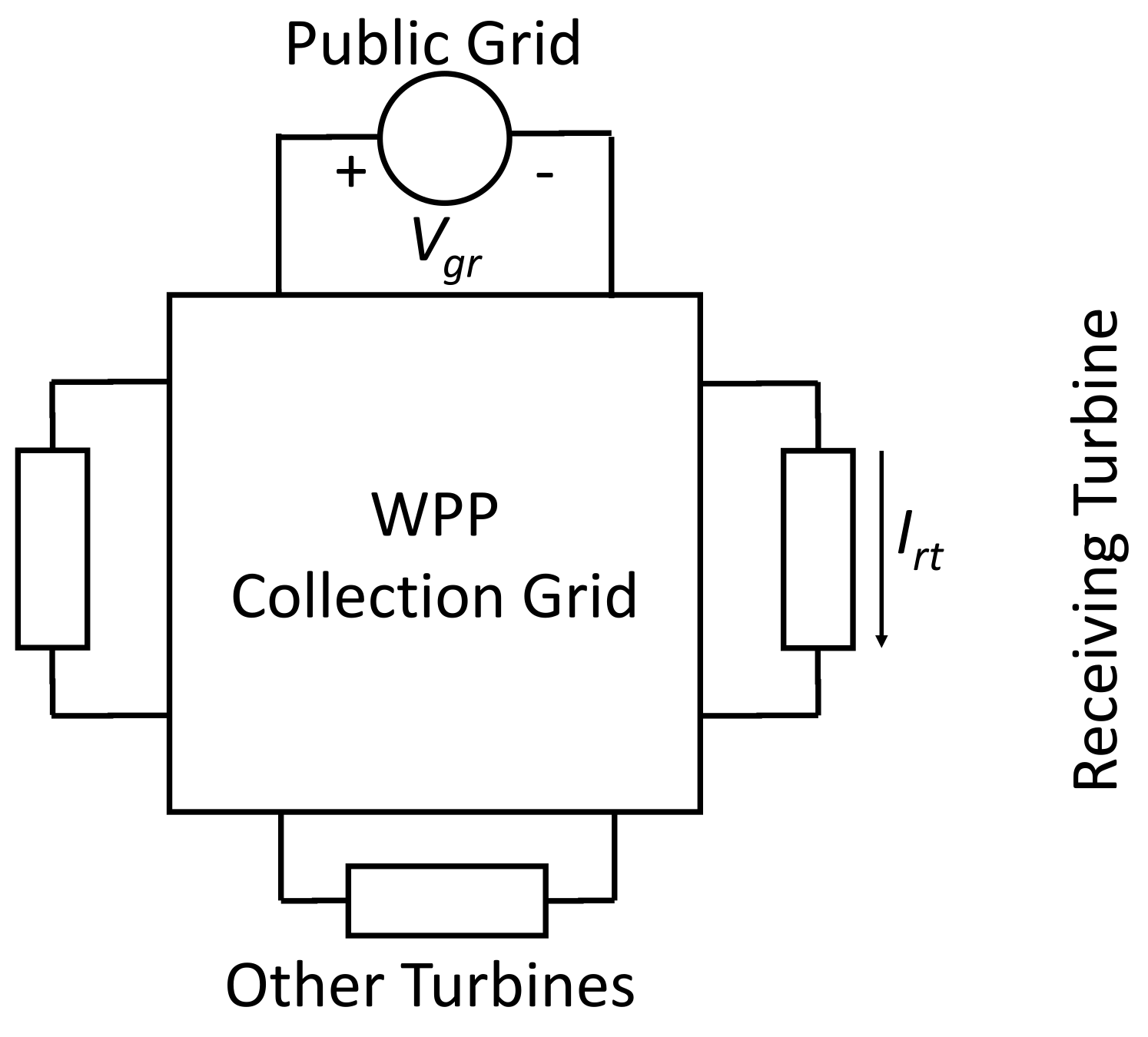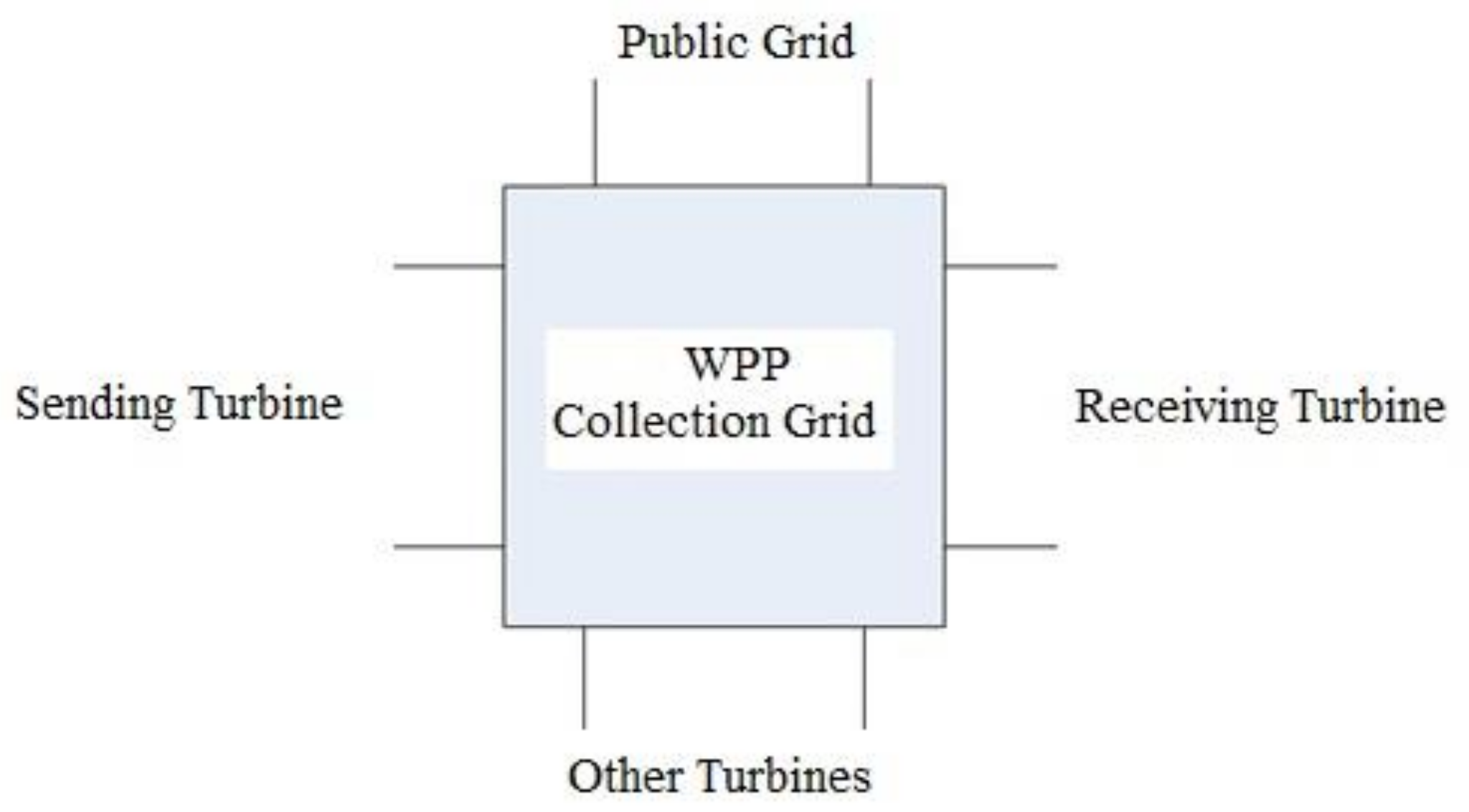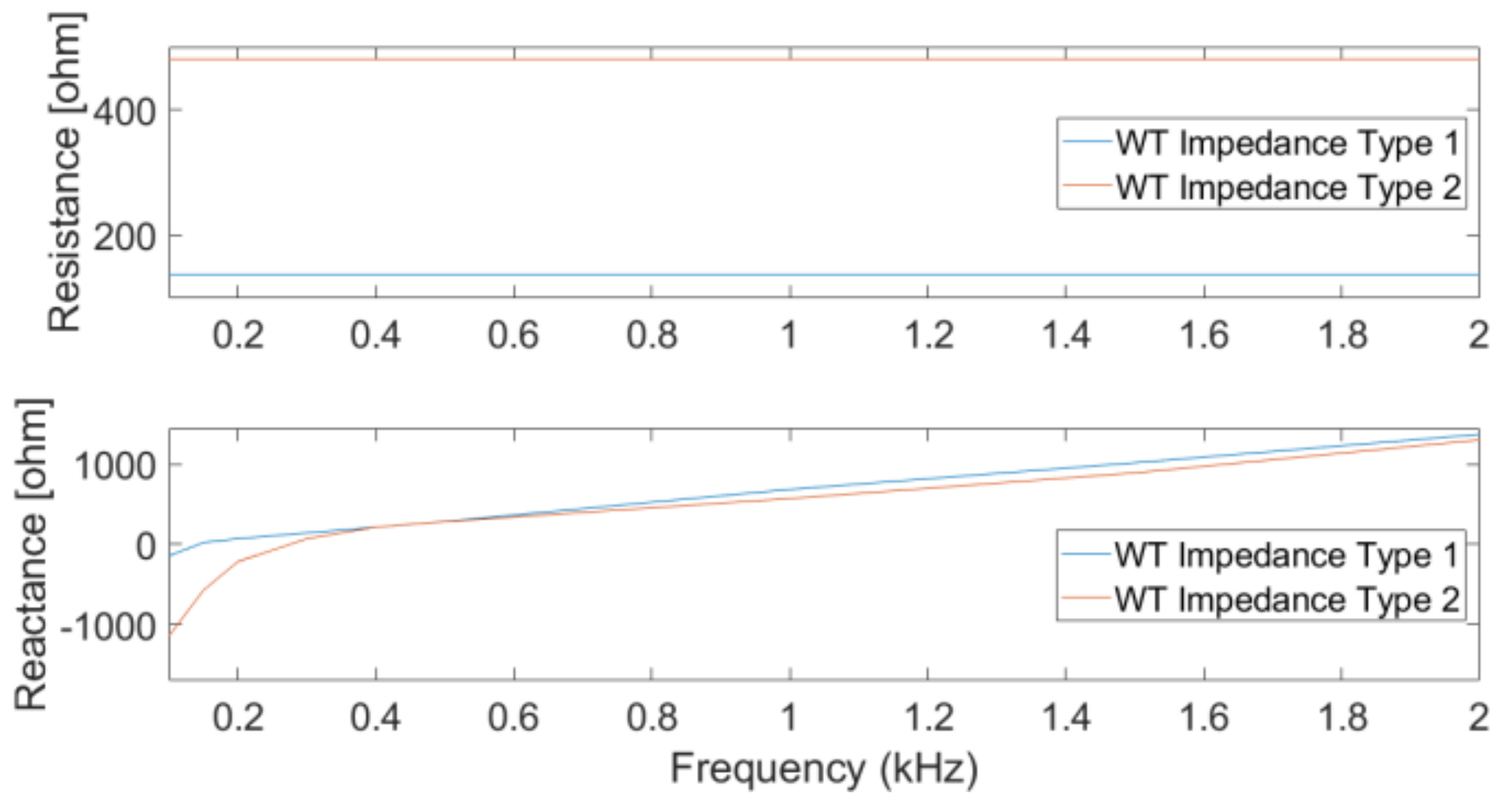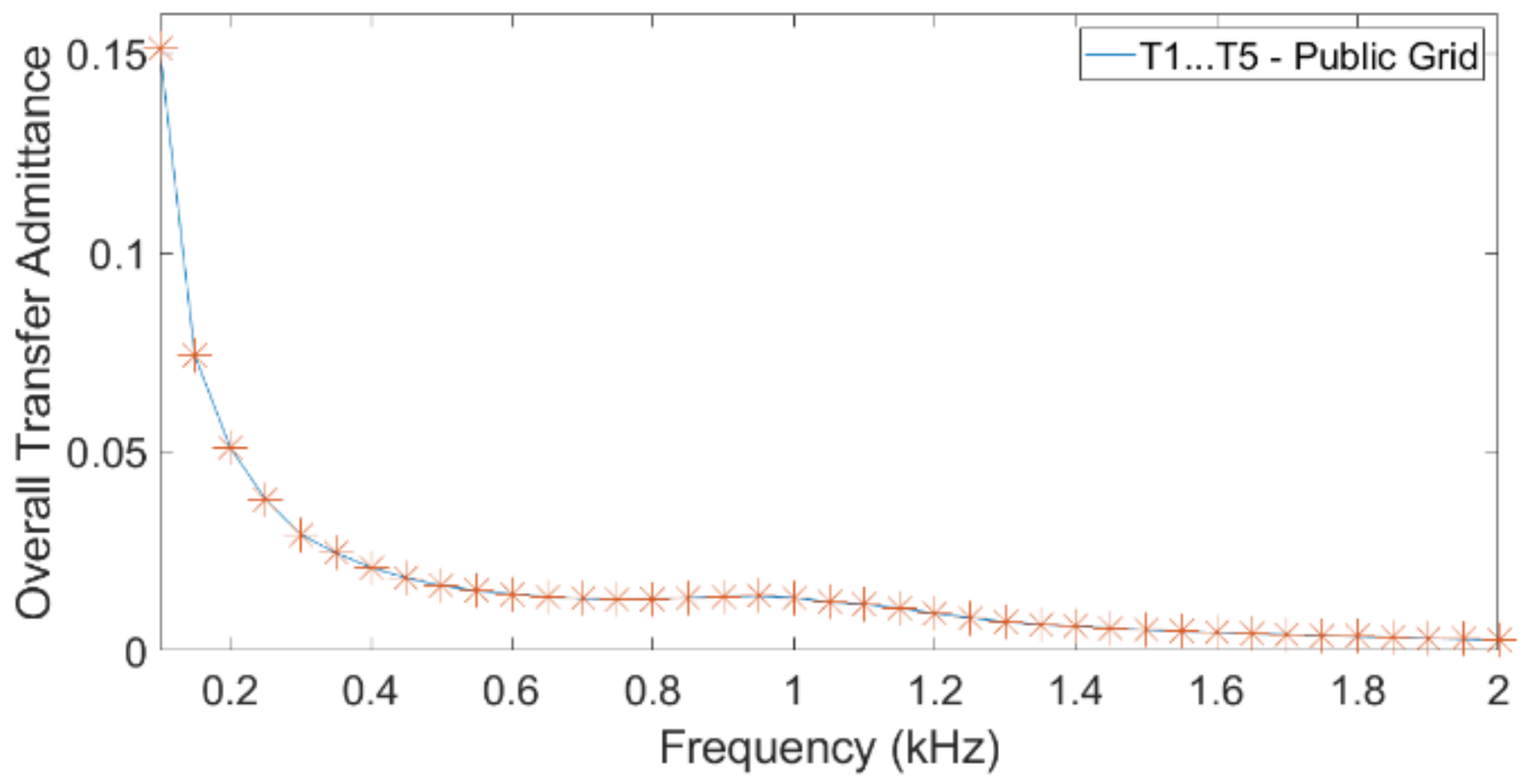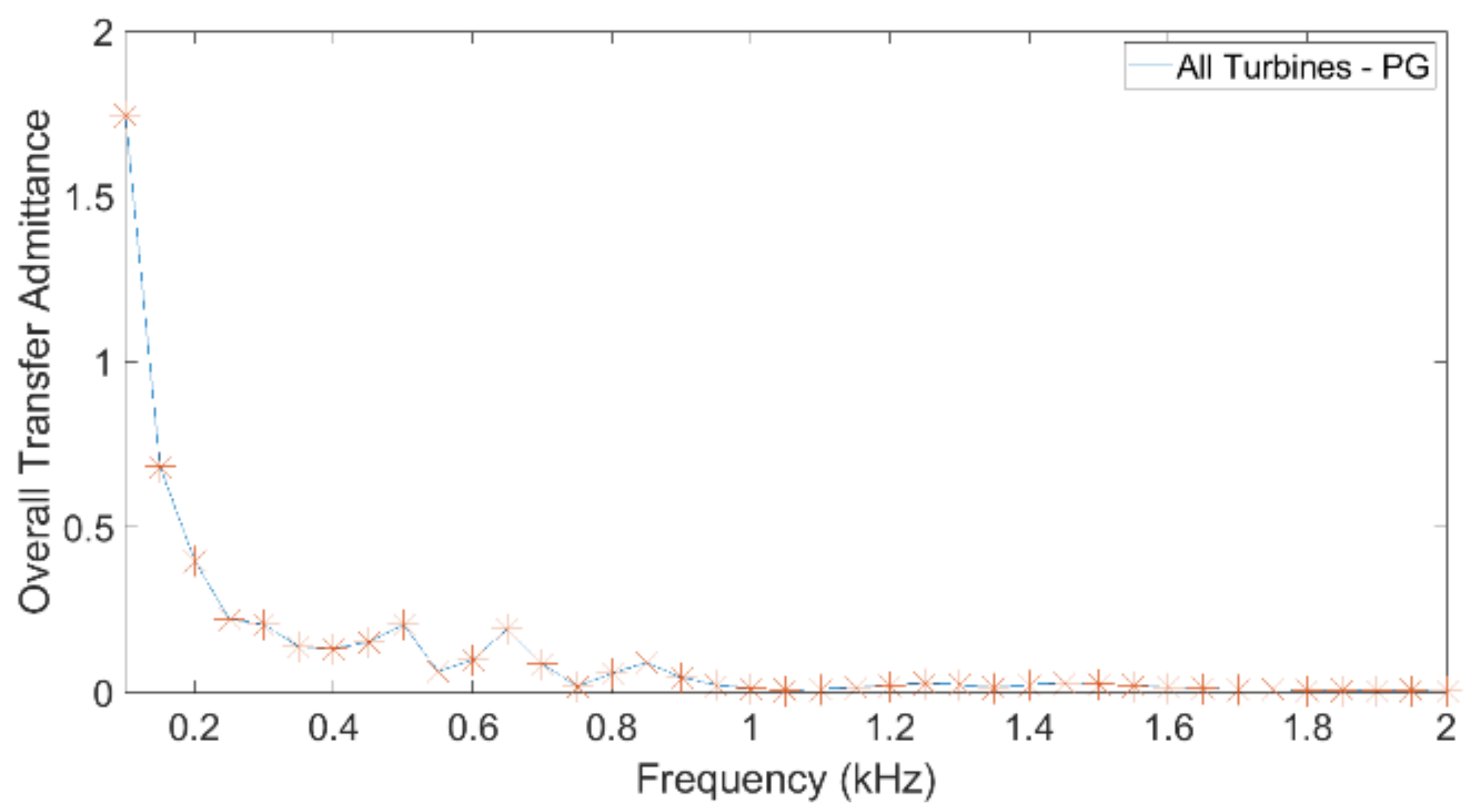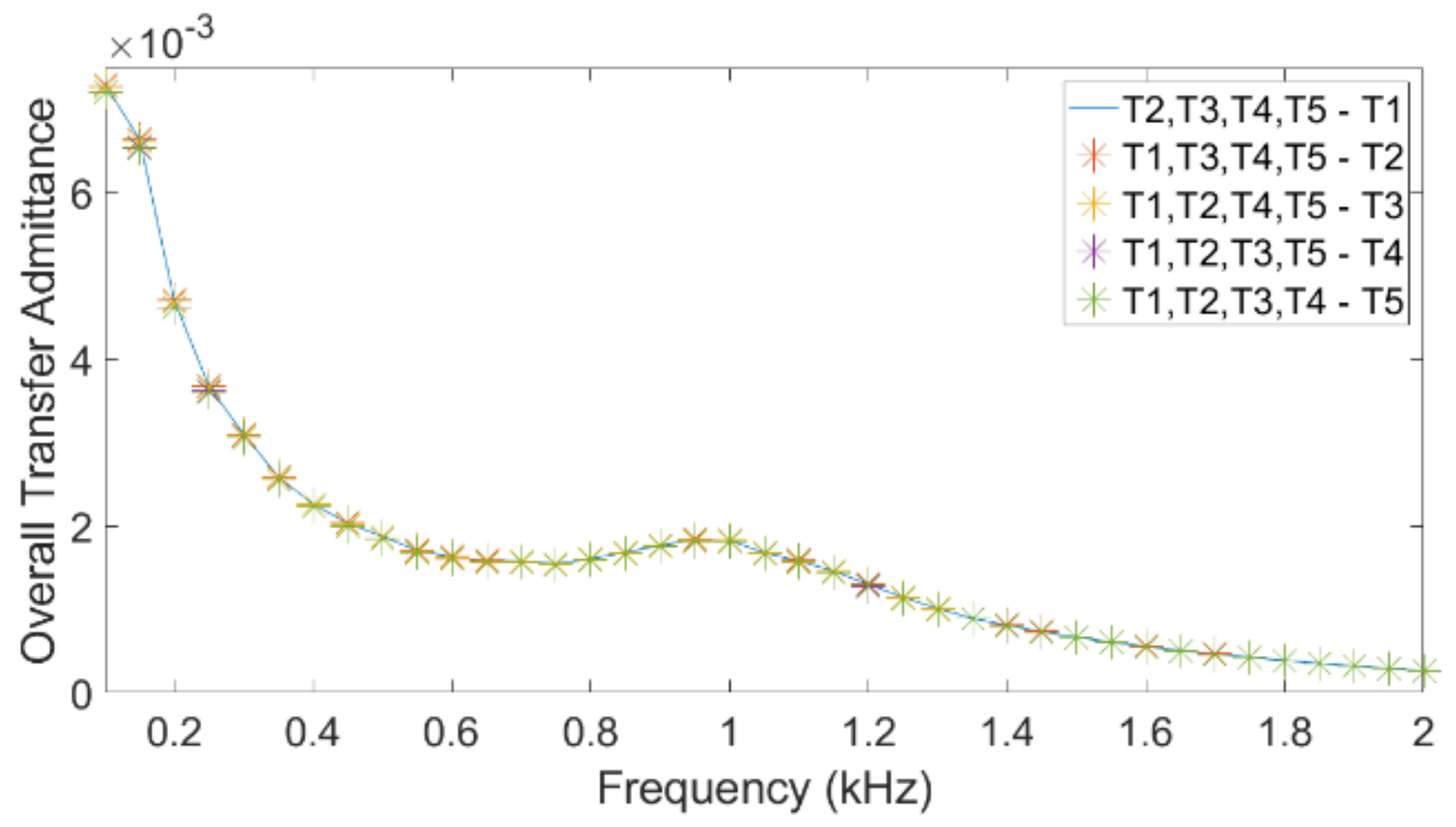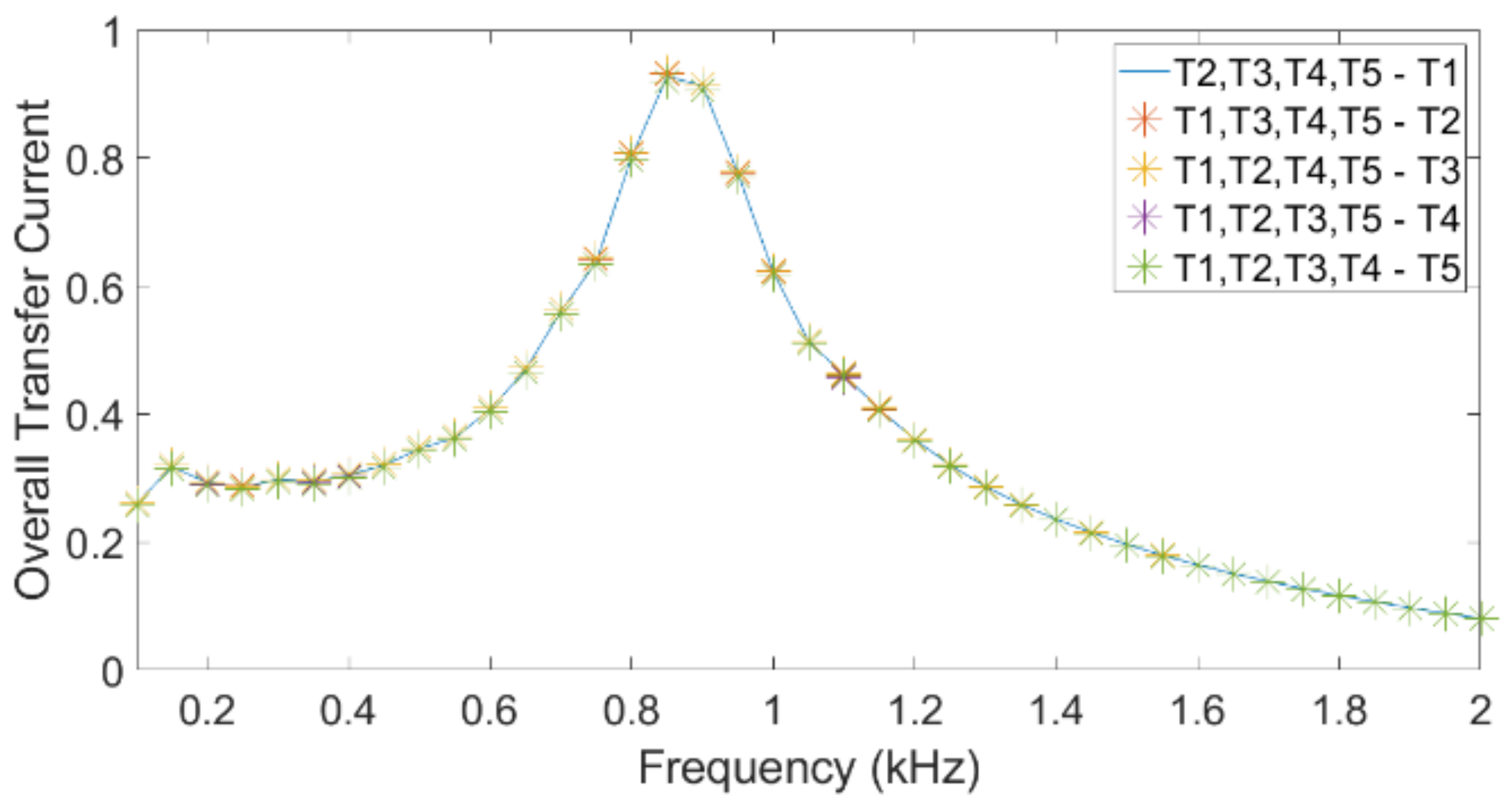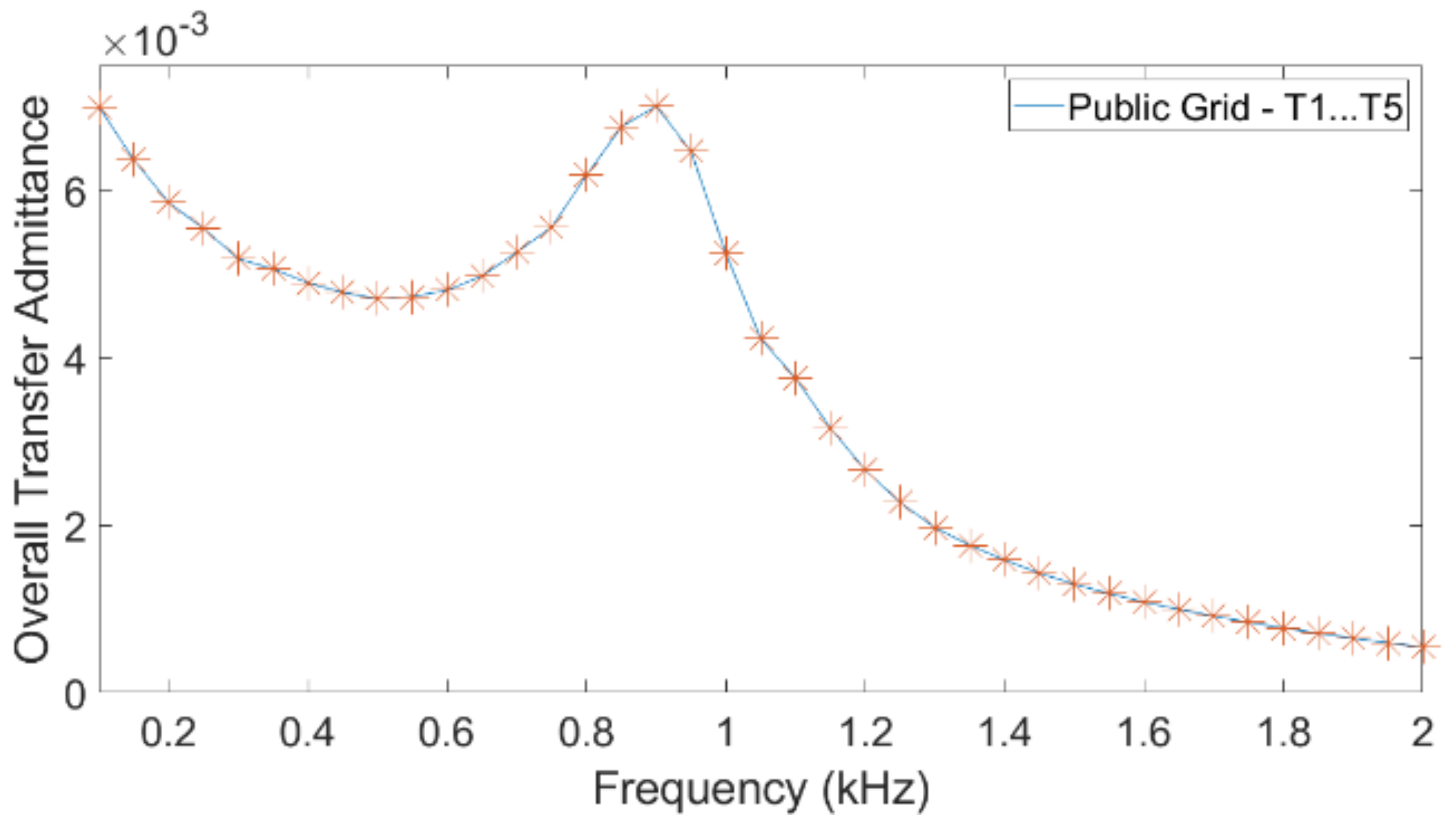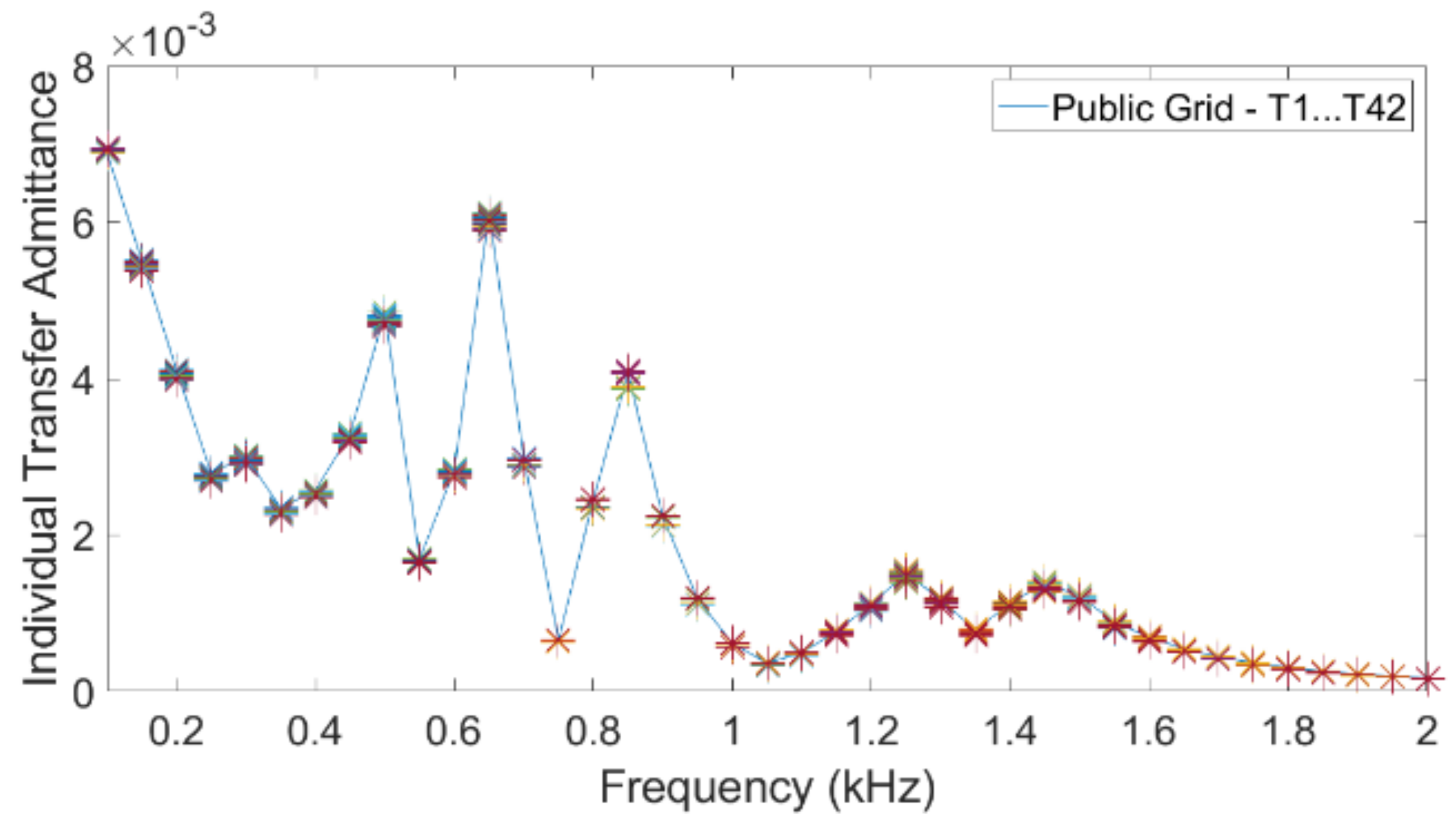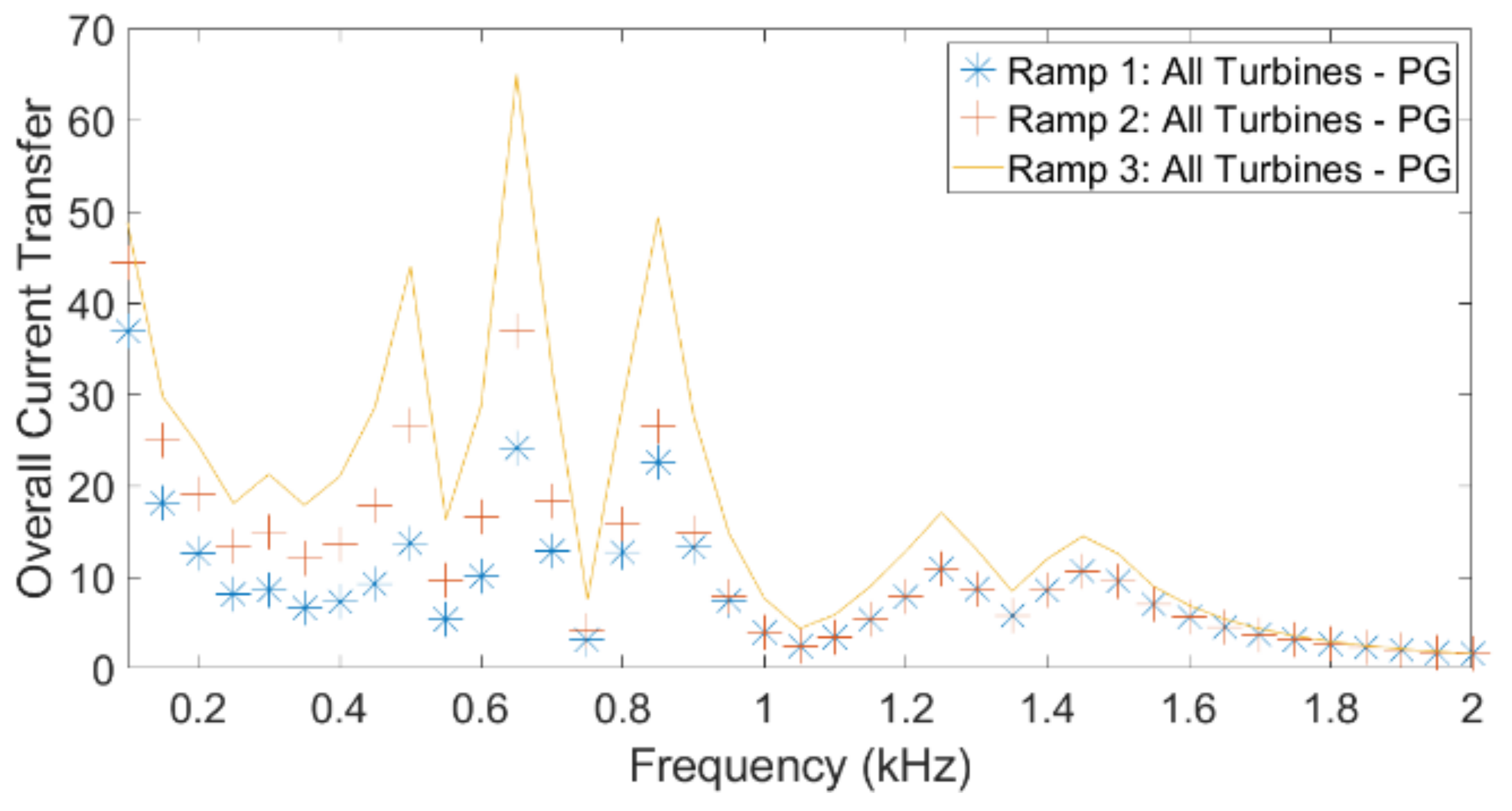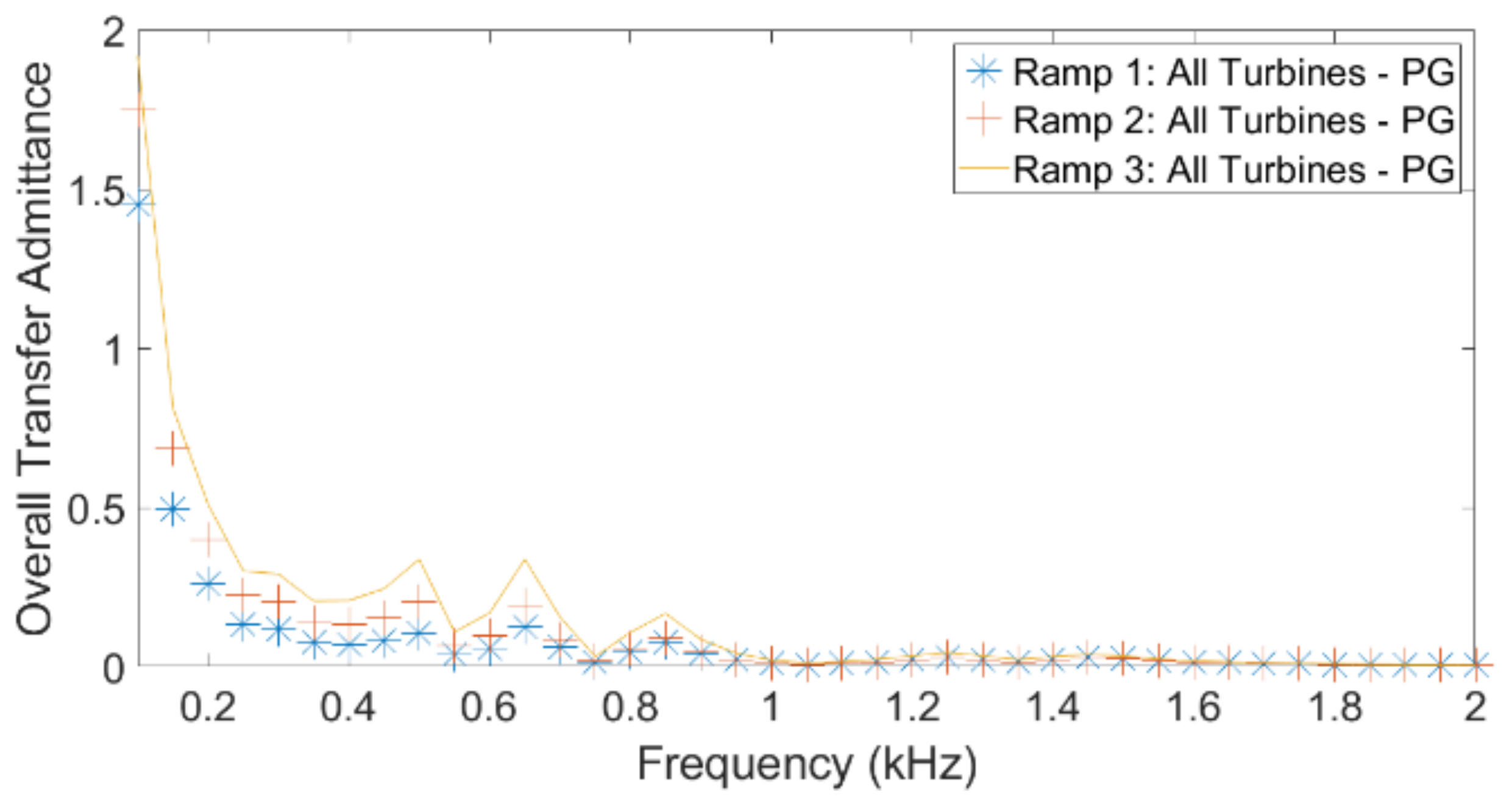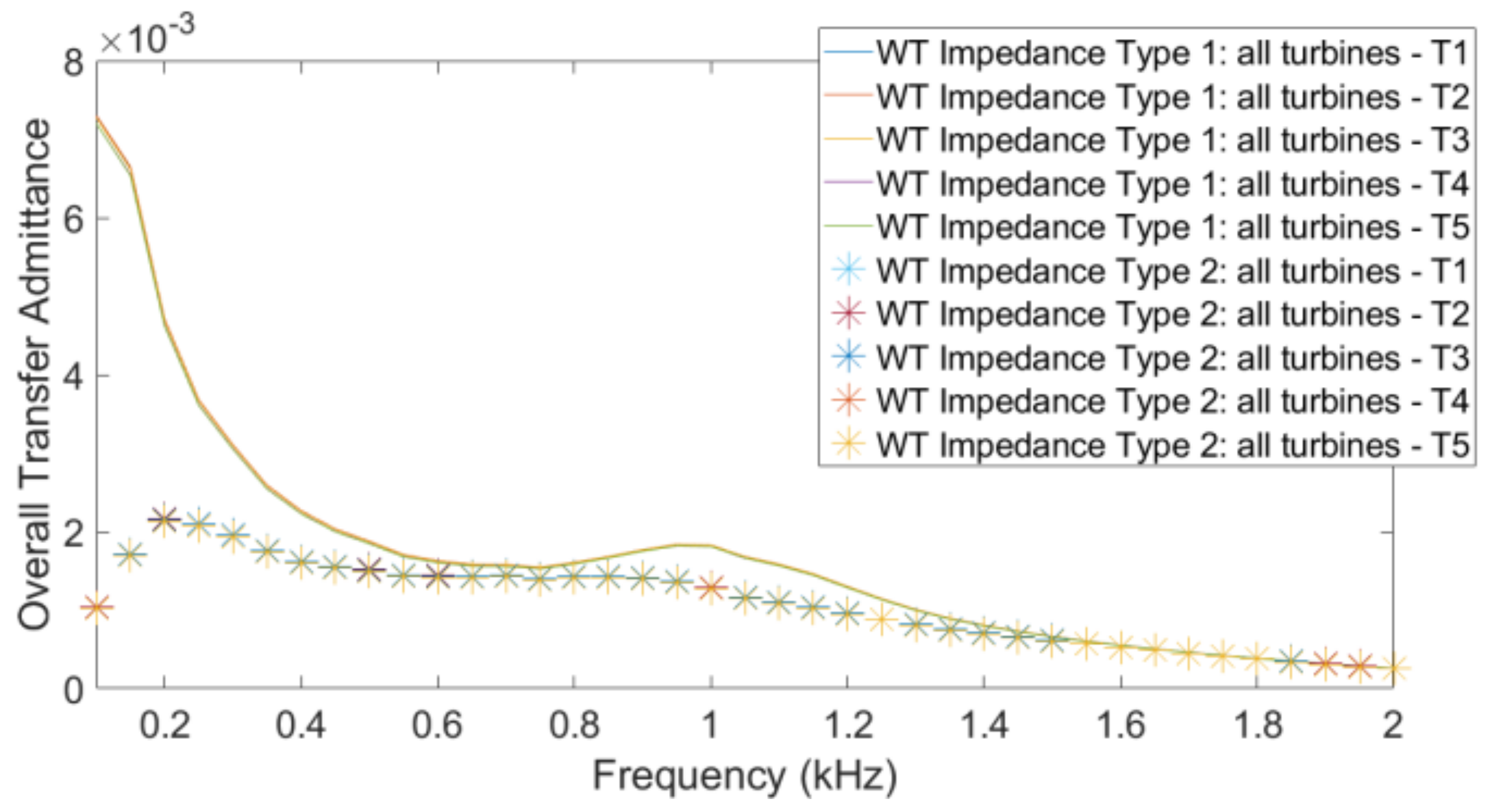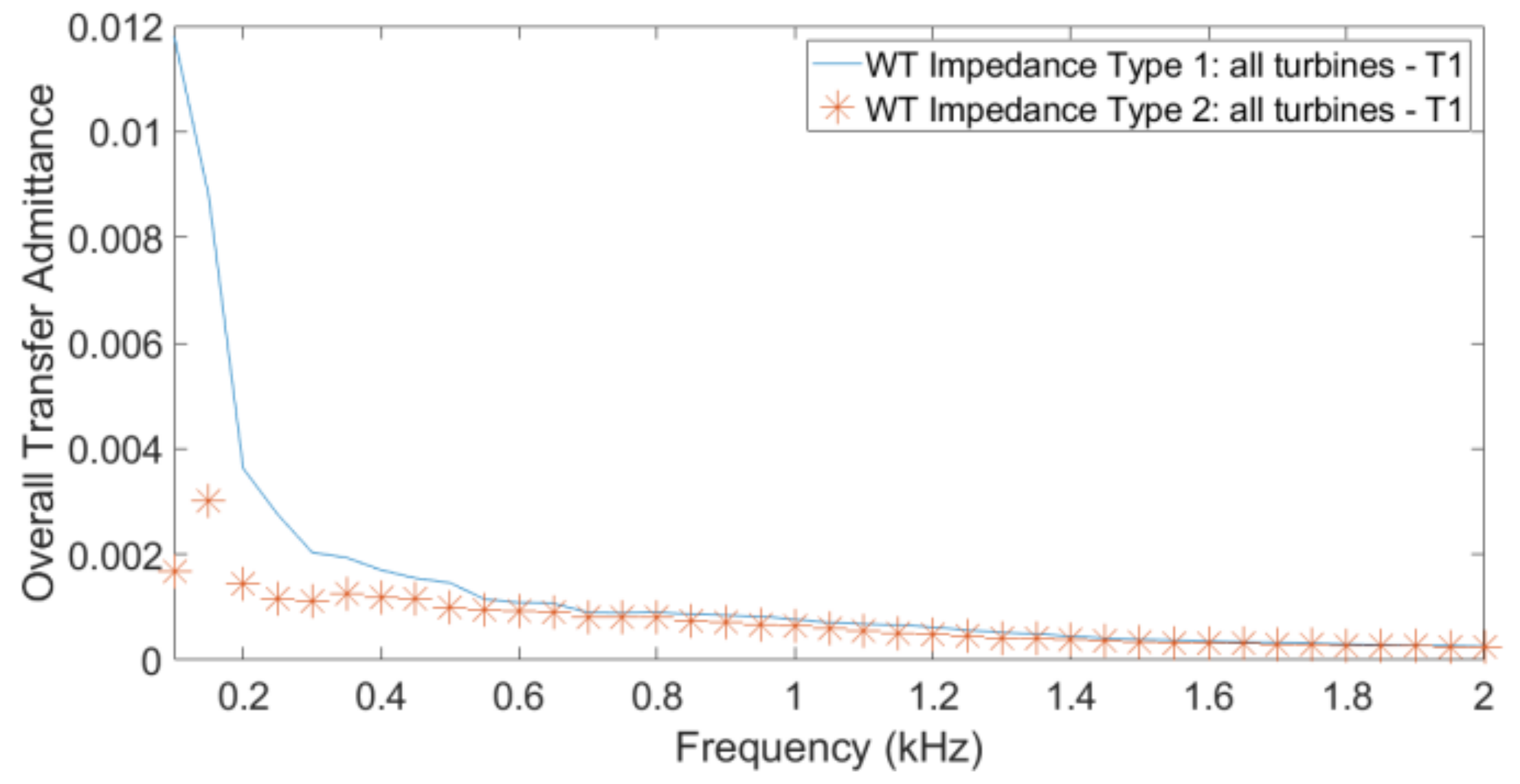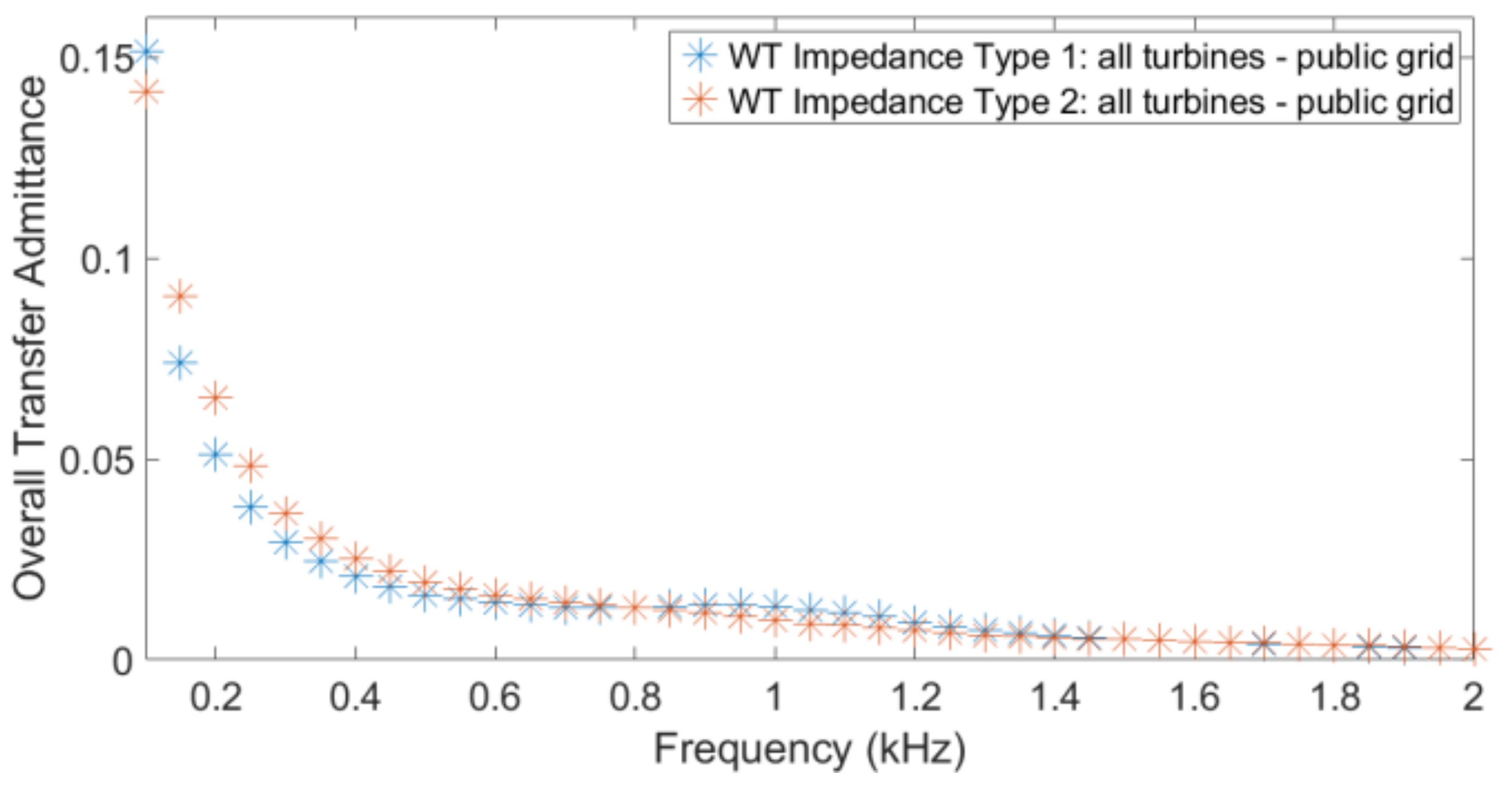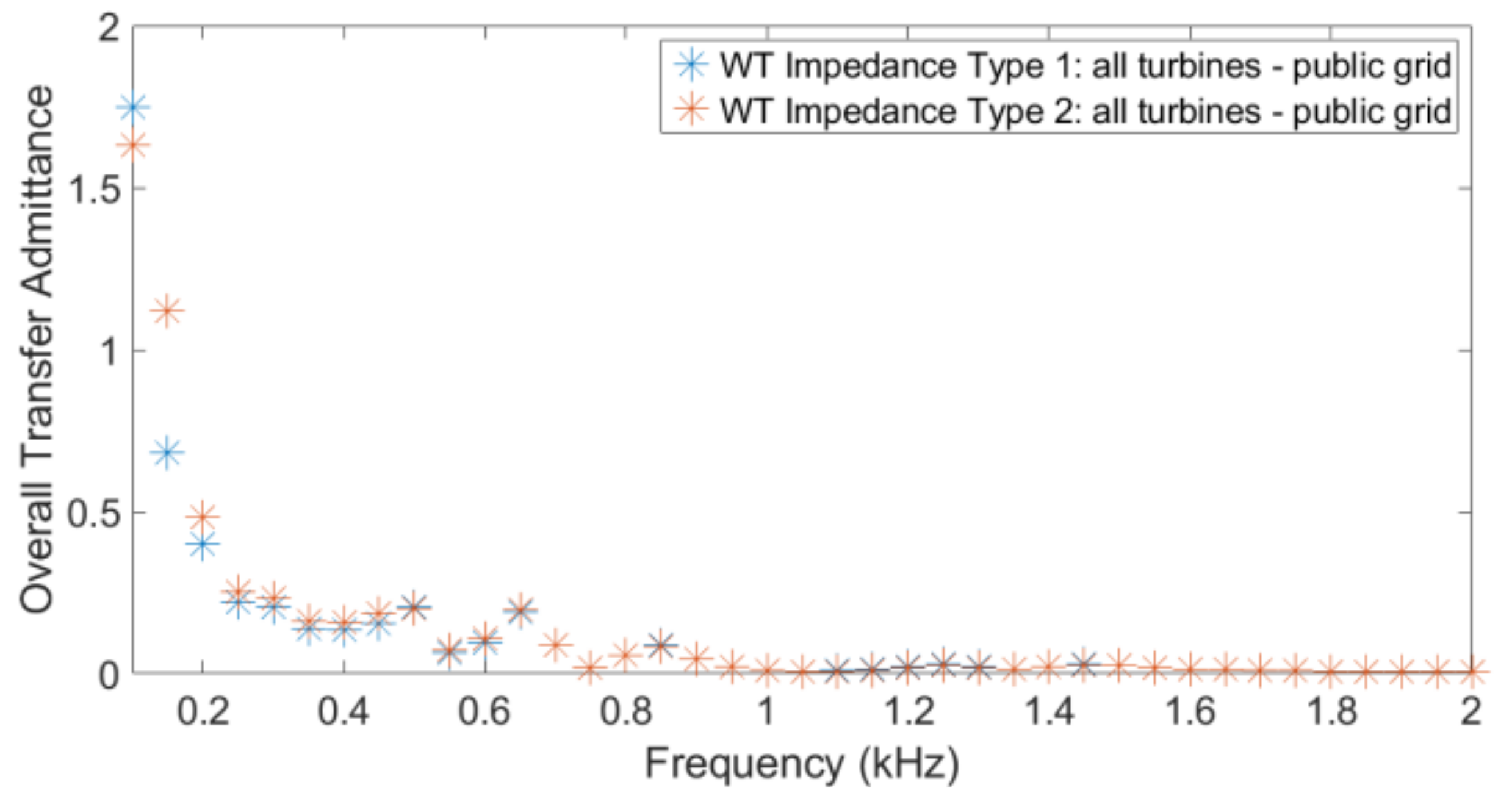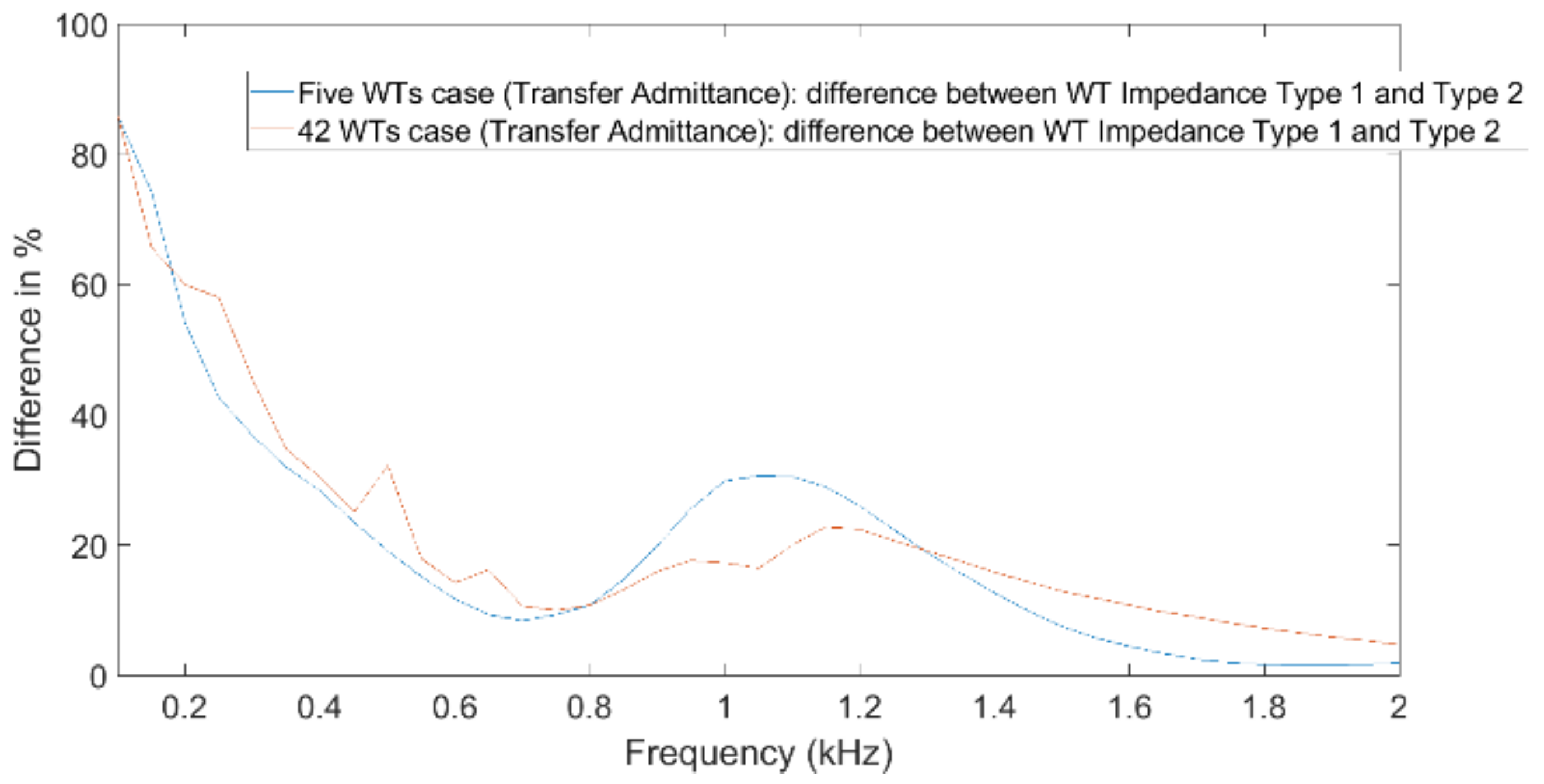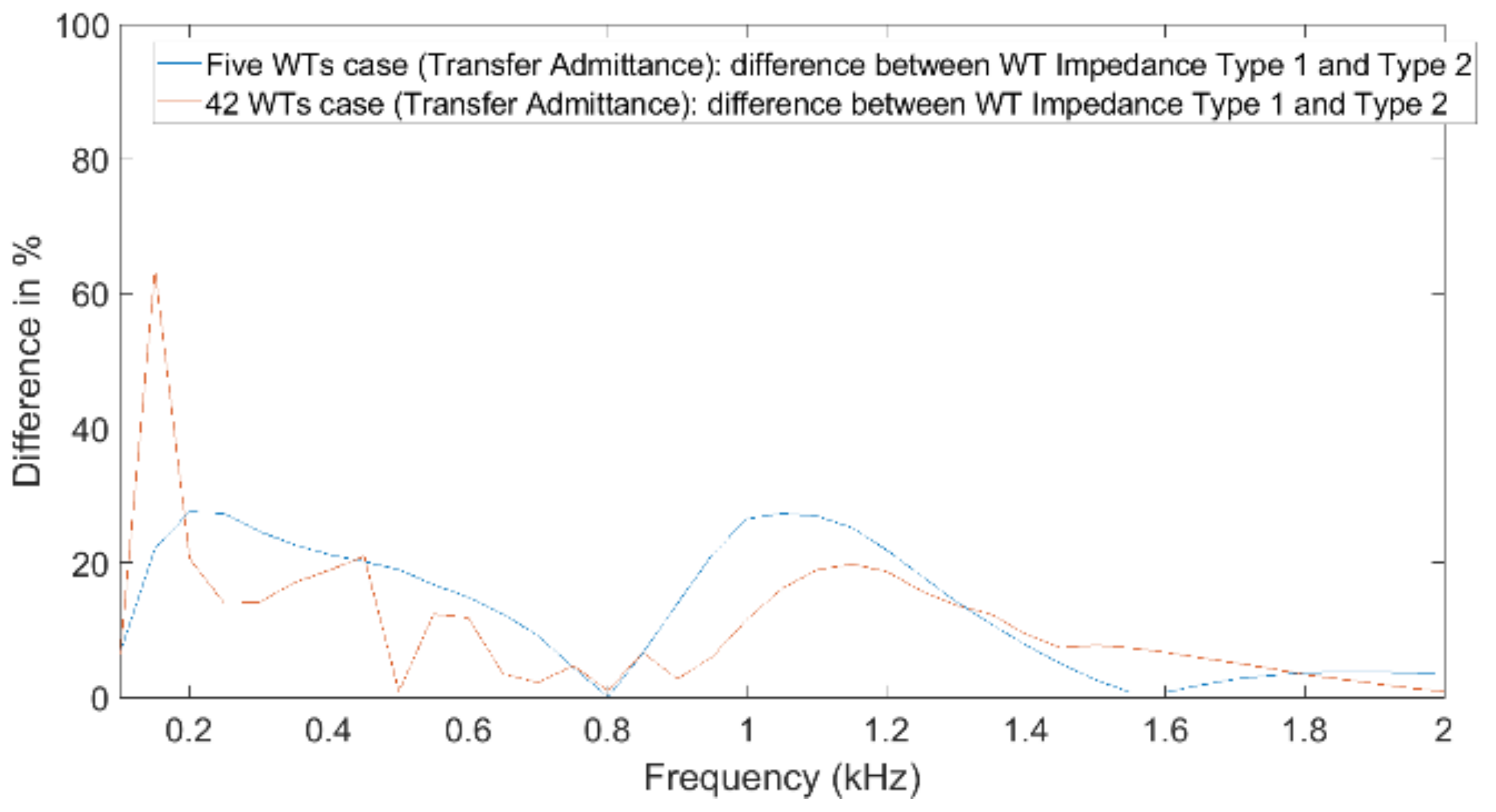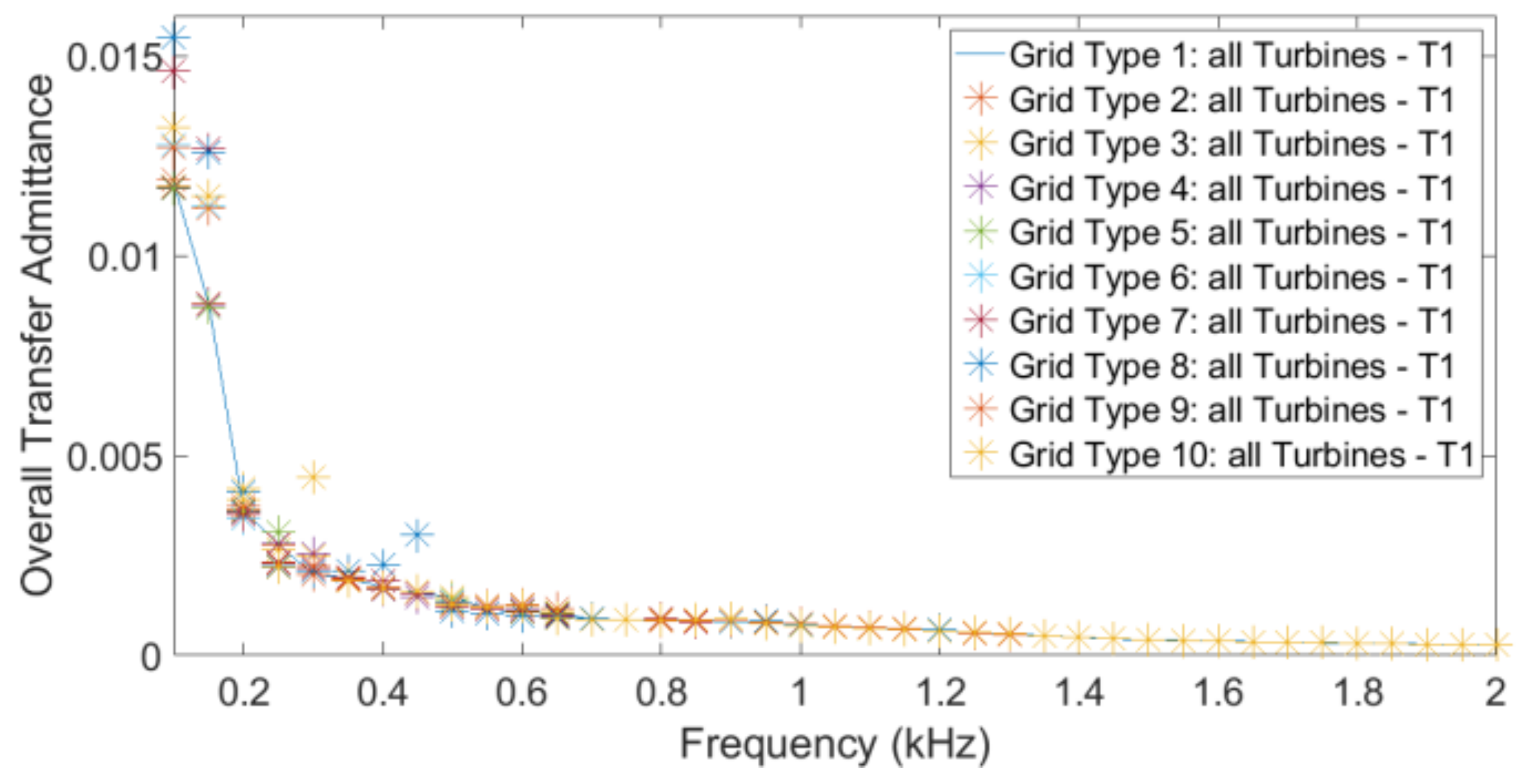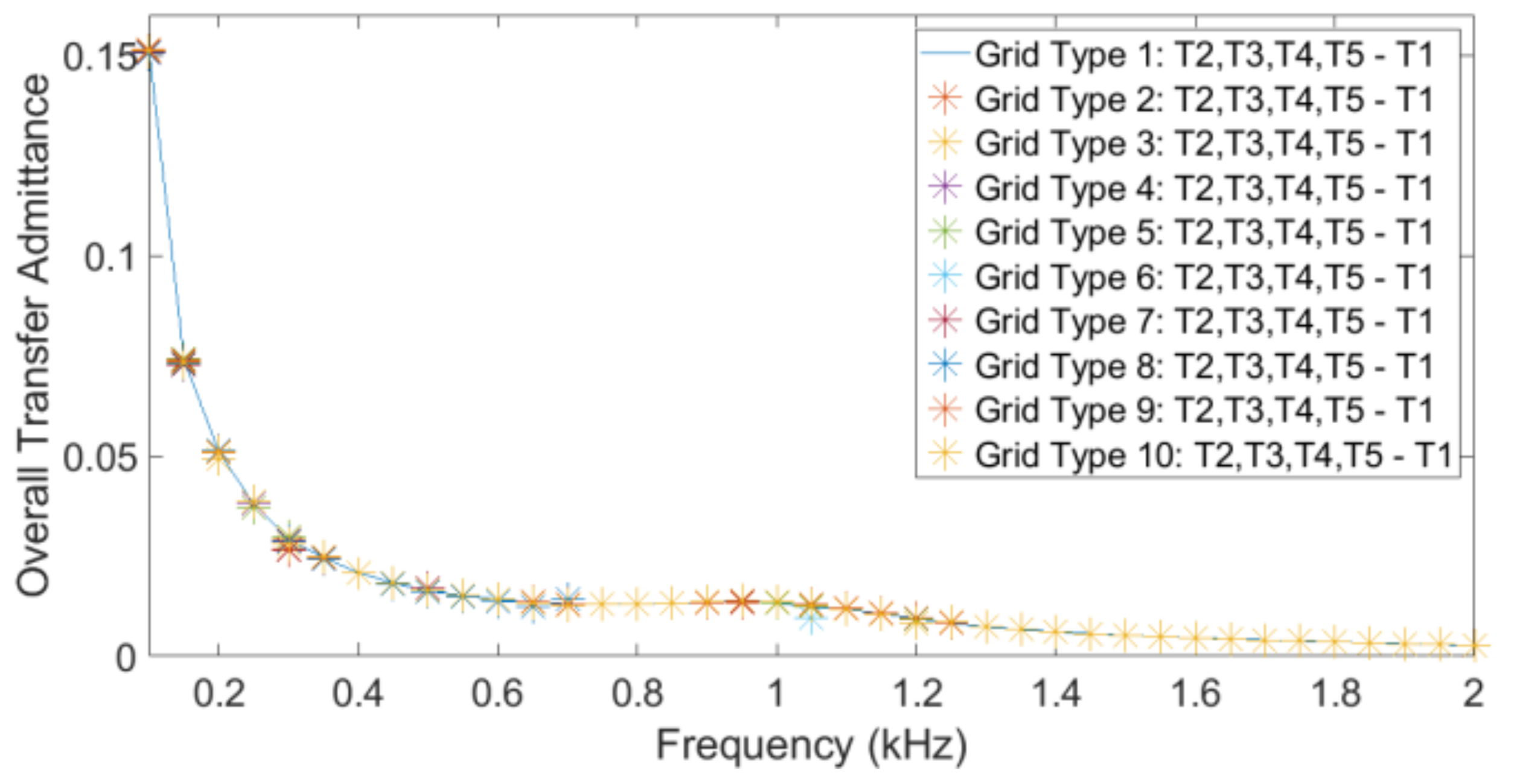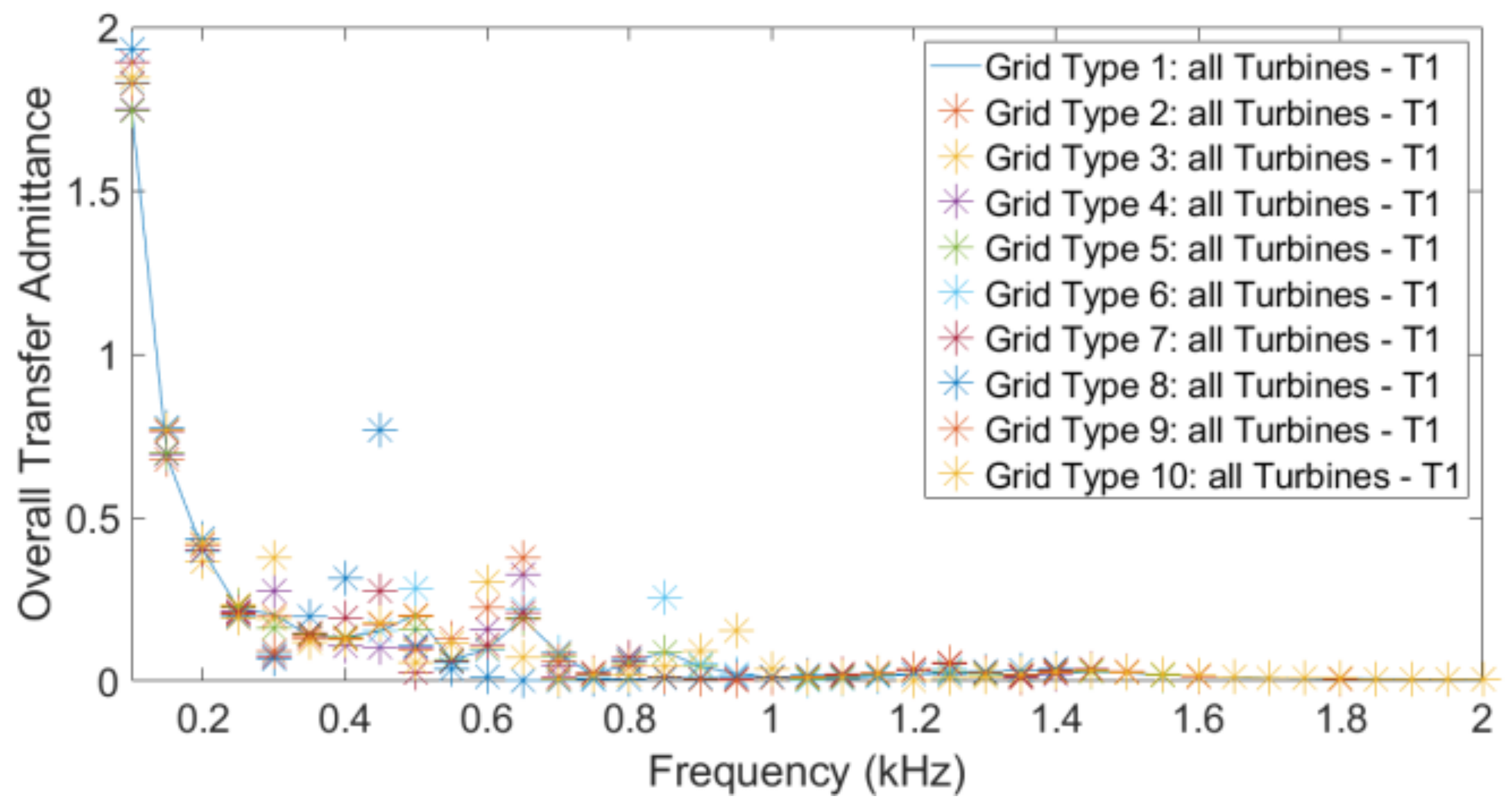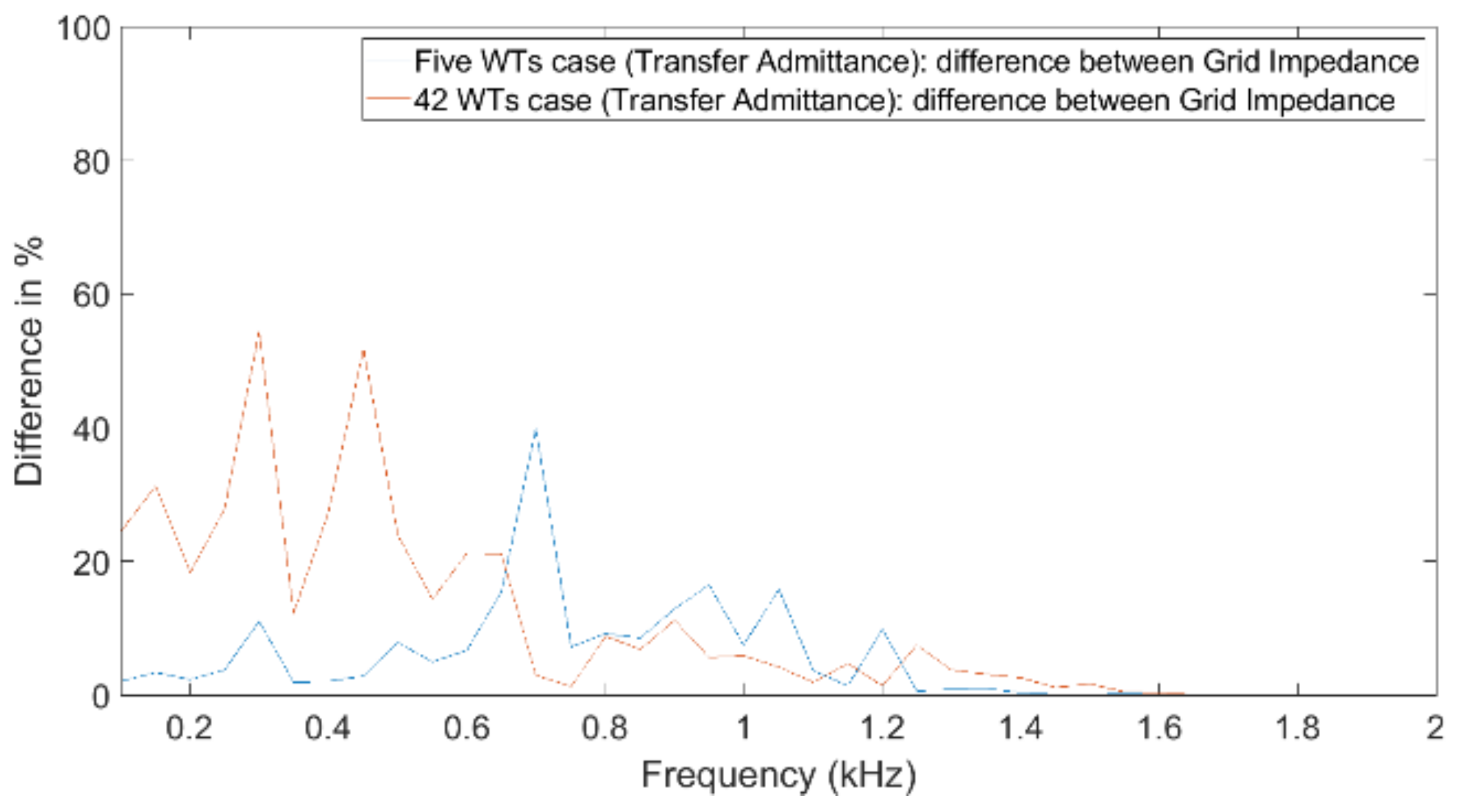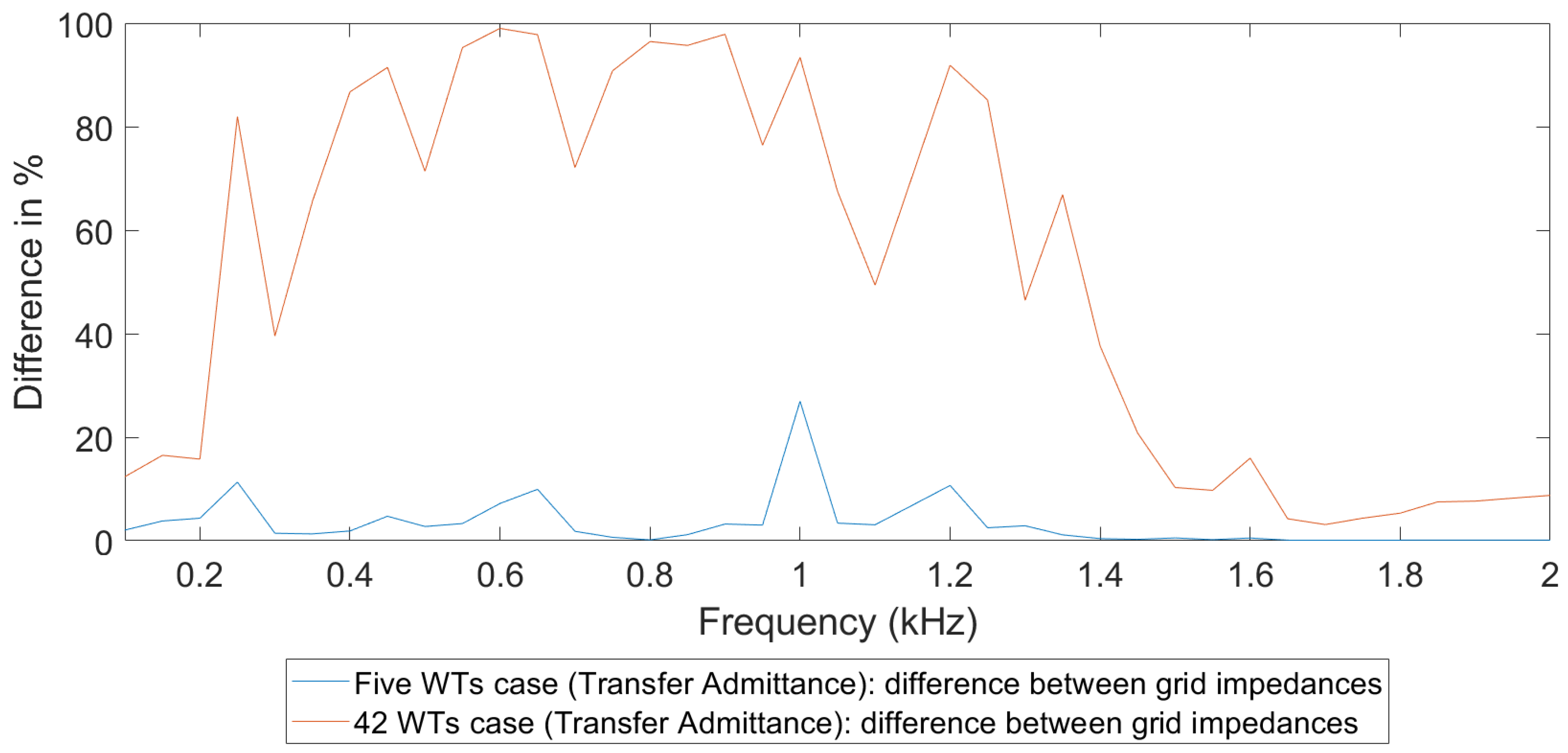1. Introduction
With the increasing number of wind power plants (WPPs), studies are regularly performed to determine their impact on the power grid, including studies of their harmonic emission when being connected to the public grid [
1,
2,
3,
4,
5]. Alternative control methods and harmonic filters to reduce the harmonic emission from wind turbines have been studied in a number of publications as well [
6,
7,
8,
9,
10,
11,
12]. Requirements set by network operators have to be fulfilled, including those for harmonic emission. The requirements commonly refer to the approaches and limits in IEEE 519 [
13] and IEC 61000-3-6 [
14]. Both assume that emission is only caused by the turbines in the WPP and not by any external sources. The IEC standard for assessing power quality from wind turbines, IEC 61400-21 [
15], acknowledges, in an informal annex, the potential impact of so-called “background distortion” on the emission [
16,
17]. The possible impact of background distortion for individual turbines and for the WPP as a whole is mentioned in a range of publications (for example, [
18,
19,
20,
21,
22]).
The study presented in [
23] shows that the emission from a WPP can result in higher distortion levels elsewhere in the transmission grid than at the terminals of the WPP, so-called “amplification”. That study does not consider possible amplification or transfer inside the WPP.
The emission from wind turbines is difficult to predict in the design stage of the park, and even measurements performed during operation rarely give unambiguous information on the actual emission from a turbine or from a park; both the operating point and the background voltage distortion play an important role [
24]. Standards and connection agreements do emphasize the calculation of harmonic voltages and/or currents at the point of connection between the park and the public grid [
25]. Due to the various uncertainties in emission from the turbines, any calculation result will be uncertain as well [
26].
An alternative approach, worked our further in this paper, is to study the propagation of harmonics through the park and between the turbines and the grid in the form of transfer functions, instead of attempting to calculate the actual harmonic voltage and/or current levels. The transfer functions are mainly determined by the impedances in the network; neither primary emission nor secondary emission have any impact on the transfer functions. This allows a study of the propagation of harmonics without any knowledge of the emission from the turbines or of the background voltage distortion.
The terms “primary emission” and “secondary emission” were introduced in [
27] and first used in the context of wind power in [
28]; concise definitions are given in [
29,
30]. The part of the current at the interface between a device and the grid that is driven by sources inside the device is defined as primary emission. The secondary emission is driven by sources outside the device. For a WPP, the primary emission originates from inside the WPP and the secondary emission from sources outside the WPP [
31]. The fact that background voltage contributes to the harmonic current at the terminals of an installation was known, but this specific terminology was new. With a WPP, the separation between primary and secondary emissions becomes more complicated because there are multiple sources of emission. In [
32], some of the transfer functions are studied, but no complete overview or systematic approach is given.
One of the consequences of high secondary emission is that it becomes difficult to determine through measurements what the actual contribution is from an individual turbine or from a multi-turbine WPP to the harmonic distortion. Distinguishing between primary and secondary emissions has been a study subject since long before the terminology was introduced (see [
33] for an overview). The general problem is mathematically under-defined and can hence not be solved without making specific assumptions or obtaining additional information. One of the consequences of this is that measurements alone cannot give the primary emission for an individual turbine or for a multi-turbine WPP.
Secondary emission is also the communication channel through which harmonic instability [
34] between turbines manifests itself. The smaller the secondary emission, the smaller the risk of instability.
Transfer functions are suitable tools for studying the spread of harmonics through a WPP, because they are independent of the emission from the individual harmonic sources [
31]. The transfer function method has been widely used in electric circuit theory, power electronics, control theory and elsewhere. In [
35], an iterative method is developed to synthesize one-port and multi-port equivalents for analysis of power system transients. In [
36], harmonic transfer functions are used for modelling linear time periodic systems in a diode converter locomotive. The method is shown to give suitable results for estimating resonance risks and harmonic interaction. In [
37,
38], harmonic transfer functions are used for analysis of linear time periodic systems.
The transfer from the turbines to the public grid, through the collection grid, is studied in [
39], where the terms “individual transfer function” and “overall transfer function” were first used in the context of wind power harmonics. A simplified model of the wind plant is used in [
40] to illustrate the concept, but only for primary emission. Primary and secondary emissions for a planned offshore plant with 48 turbines are presented in [
23], using the transfer function approach proposed in [
39]. The collection grid, the offshore part of the public grid, turbine transformers and filters are modelled in [
23], where manufacturer-provided models of the filters are used. It is shown, among others, that the harmonic current at the WPP terminals is dominated by the secondary emission. It is also shown that series resonance can result in amplification of the harmonic voltage distortion from the public grid to the collection grid. The transfer and aggregation of the emission from individual turbines to the public grid is presented in [
40] for a hypothetical 10-turbine plant. Only primary emission is considered in that study. Primary and secondary emissions, at different locations in the plant, are studied for an existing nine-turbine plant in [
32]. Propagation (referred to as “harmonic interaction”) between different WPPs is studied in [
41]. Aggregation in a 10-turbine WPP is studied in [
42]. A simplified approach to address resonances in WPPs, in relation to instabilities and negative damping with wind turbines, is presented in [
43]. In [
44], a transfer function (referred to as “frequency scanning”) is used to detect resonances for a WPP.
In this paper, the concept of primary and secondary emissions will be extended further for a WPP by considering the different harmonic transfers in a systematic way. A range of different transfer functions is calculated for a 5-turbine hypothetical plant and for a 42-turbine existing plant. It is shown that secondary emission is a substantial part of the emission, over the harmonic frequency range, both for individual turbines and for the WPP as a whole. This paper gives, for the first time, numerical values on the amount of secondary emission with individual turbines due to the emission from other turbines. Numerical values are also given for the relation between primary emission and secondary emission driven by sources outside the plant. In the main body of the paper, the terms “primary emission” and “secondary emission” will only be used to a limited extent. Instead, transfer admittances and current transfers will be used. These transfer functions are independent of the primary emission but will allow a comparison in magnitude between primary and secondary emissions. This comparison is done in the Discussion section of the paper.
Section 2.1 of this paper summarizes the concept of transfer functions;
Section 2.2 introduces one of the main uncertainties, the turbine model. Most wind power plants contain multiple turbines, so some kind of aggregation of the emission is needed. The “overall emission” is introduced in
Section 2.3 to include aggregation in the studies. The calculation method is explained briefly in
Section 2.4, and the case studies are introduced in
Section 2.5, which is mainly a reference to the appendices where the detailed data are found. For readers not familiar with transfer functions, they are briefly explained in
Section 2.6. The results considering the transfer admittance and current transfer for both case studies are presented in detail in
Section 3. Some of the results are discussed in
Section 4.
2. Materials and Methods
2.1. Harmonic Transfer Functions
Without knowing the harmonic emission of a wind turbine (WT) converter, it is not trivial to distinguish between primary and secondary emissions. However, with the use of transfer functions, it is possible to estimate the spread of these emissions using only impedances.
To quantify the harmonic contribution from different harmonic sources within a WPP, different transfer functions are available: voltage and current transfer functions as well as transfer impedances and admittances.
The harmonic transfers in a WPP can be quantified through a number of transfer functions: voltage transfer, current transfer, transfer admittance and transfer impedance. A multi-port circuit representation is presented in
Figure 1 to illustrate how the transfers were obtained.
For the multi-port network shown in
Figure 1, one sending port and one receiving port are selected. The transfer functions can be calculated for given terminations at the other ports. The sending turbine is defined as the one that is generating harmonics. The receiving turbine is defined as the one receiving the harmonics contribution. The “other turbines” in
Figure 1 affect the transfer through the turbine model used, i.e., through the termination of these ports. The four transfer functions used in this paper are further explained in
Appendix E.
2.2. Turbine Model
Two competing models are widely used and discussed in the literature and beyond for the harmonic emission from a wind turbine: the “voltage-source model” and the “current-source model” [
22,
45,
46]. Neither model gives a correct representation of reality, but both models can be viewed as extreme cases. Realistically modelling a voltage-source converter for harmonic studies is complicated, and a range of papers have been dedicated to this, many being trigged by [
47]. Such detailed modelling is beyond the scope of this work; instead, the emphasis is on the transfers between the different converters and the grid, not on the detailed modelling of the converters. A reason for not considering detailed modelling of the converters is that such knowledge is often not available when doing studies on harmonic emission in WPPs. Sainz et al. [
48] present a simplified but accurate expression for the apparent impedance of a wind turbine. For results presented in this paper, the WT impedance was obtained assuming the positive sequence results shown in ([
48], Figure 4). These values include the WT converter impedance and the filters. The impedances used in this paper are shown, as a function of frequency, in
Figure 2. The difference between the two types in
Figure 2 is the bandwidth of the grid voltage low-pass filter
that was considered using Equation (2). For type 1, it was considered to be
, and for type 2, it was considered to be
. More details are found in ([
48], Table 2). For this study, the impedances were calculated assuming a voltage level of 33 kV.
where
is the fundamental angular frequency.
For the calculation of the transfer function, the primary emission is modelled as an ideal voltage or current source. This does not, however, imply any assumption on which model is more representative. When calculating, for example, the transfer admittance, the primary emission for all turbines except the sending one is considered equal to zero.
2.3. Individual and Overall Transfer Functions
An individual transfer function quantifies the transfer of harmonic voltage or current from a sending port to a receiving port, as illustrated in
Figure 1. Each of these is a complex value that is a function of frequency. The transfer impedance matrix and the branch impedances were used to obtain the different transfer functions. In this paper, two transfer functions were used: the current transfer and the transfer admittance.
The “overall harmonic transfer” is defined as the total transfer from a number of sending ports (turbines) to one receiving port (turbine or public grid) [
28,
40,
49].
Consider, as an example, the current transfer from turbine to public grid. The individual current transfer function is the complex ratio between the current at the public grid terminals and the current at the inverter terminals of a specific turbine, under the assumption that the emission from all other turbines is zero. The overall current transfer is defined as the ratio between grid current and turbine current when the emission is the same for all turbines. The “emission” can in this case be the absolute value of the complex current; it can also be a statistical index, such as the 95th percentile. Note that the overall transfer function is a real function of frequency, whereas the individual transfer function is a complex function of frequency.
To calculate the overall transfer from the individual transfer functions, an aggregation rule between individual turbines has to be considered. Assuming the commonly used aggregation model in IEC 61000-3-6 [
14], with aggregation exponent
, the relation between overall and individual transfers reads as Equation (2).
where
is the overall transfer function,
is the individual transfer function from turbine
k to the public grid and
N is the total number of turbines. It is the aggregation rule as defined in Equation (2) that has been used in this paper.
2.4. Calculation Method
To calculate the different individual transfer functions, the collection grid, the turbines and the public grid were all modelled as series and shunt impedances. A single-phase model was used, representing only positive- and negative-sequence harmonic components. Both transmission and turbine transformer were delta-star-connected, blocking any zero-sequence harmonic component. There was no transfer of zero-sequence components between the turbines or between turbines and the public grid.
All impedances, voltages and currents were transformed to the 33 kV voltage level of the medium-voltage collection grid. To avoid difficulties with interpretation of the results, relevant values of the transfer functions are presented in %/% on a base of rating of either the transmission transformer or the turbine transformer.
From the branch impedances, a node admittance matrix was obtained as a function of frequency. By inversion of this matrix, a node impedance matrix was obtained. This matrix was next used to calculate the different transfer functions as a function of frequency.
2.5. Case Studies
To illustrate the transfer function approach, the harmonic propagation was studied for two wind power plants, with 5 and 42 wind turbines, respectively. The details of these two WPPs are given in
Appendix A and
Appendix B, respectively. The 42-turbine case is an existing plant, where detailed data were obtained from the manufacturer of the installation. The 5-turbine case is a hypothetical but realistic case, where, for example, the harmonic filter selected was the same as that for the 42-turbine wind power plant.
The public grid impedance versus frequency, from 100 Hz to 2 kHz, was obtained from detailed simulations of a 220-kV grid somewhere in Europe. This data are shown in
Appendix C.
For calculation of the overall transfer functions, the aggregation exponent is needed for each frequency considered. Three models for this exponent are presented in
Appendix D: next to the IEC-recommended values [
14], two models with a smoother transition from exponent value 1 to exponent value 2.
2.6. The Rationale behind Transfer Functions
A transfer function gives the relation between an input variable and an output variable for a linear system. The most commonly used example, in electric power engineering, is Ohm’s law:
where
is the voltage over a resistive element (originally, a conductor) and
the current through that element. The resistance
is a property of the resistive element, independent of the current and the voltage. Alternatively, the ratio between voltage and current is constant, and this constant is called the resistance.
In terms of system theory, the current is the input and the voltage is the output.
For most electric circuits, the transfer functions are complex functions of frequency. Consider, for example, the parallel connection of a resistance
, an inductance
and a capacitance
. Consider the voltage
as an input variable and the current
as an output variable. The ratio between current and voltage, the admittance, reads, for this example, as
where
is the angular speed and
is the frequency. The admittance, a transfer function, is a function of frequency, but that function is independent of the actual voltage and current at any frequency.
In the examples up to now, the input and output variables have been taken at the same location in the electric circuit. In that case, we often refer to the transfer function as source or driving-point impedance or admittance. The term “transfer impedance” or “admittance” (or generally, transfer function), however, also holds for this case.
In a power grid with many elements, like the combination of a WPP and the grid studied in this paper, the calculation of the transfer functions is no longer as straightforward as in the two examples shown here. Instead, more systematic methods are used, which can be implemented in calculation software. Several software packages have the ability to perform such calculations, all using somewhat different methods. In this paper, we used the following approach:
- ➢
The complex impedances of each branch in the network were given; from these branch impedances, the branch admittances were calculated through a simple arithmetic inversion. These branches included cables (modelled as a pi-model including series resistance, series inductance and shunt capacitance), transformers, grid impedance and turbine impedance.
- ➢
The so-called node admittance matrix was obtained by adding the branch admittances one by one.
- ➢
The node impedance matrix was calculated through a matrix inversion of the node admittance matrix.
The node impedance matrix was used for the calculation of the transfer functions. Each of the branches has an impact on the elements in the node impedance matrix and thus on the transfer functions. It is, however, in most cases, not possible to identify the impact of a specific branch impedance on a specific transfer function. The combination of all branches in the network matters for the transfer function.
For a linear system with multiple inputs, the superposition principle can be used to obtain the output. A relevant example for this paper is the case with multiple turbines emitting harmonic currents that all contribute to the harmonic voltage at a specific location in the park. The voltage
at a location r is obtained from the following expression:
where
is the transfer impedance from location
s to location
r and
the injected current at location
s. Note again that voltage, current and transfer impedance are complex functions of frequency.
4. Discussion
In this paper, primary and secondary emissions of a wind power plant were studied by using different transfer functions. It was shown that the transfer functions are a suitable tool for this. The transfer functions were calculated for two cases: (i) a hypothetical WPP with 5 wind turbines and (ii) an existing offshore wind power plant with 42 turbines.
4.1. Primary and Secondary Emissions
The studies presented in this paper were triggered by the need to estimate the relative contribution of the secondary emission without knowing the details of the primary emission. This relative contribution was shown in the paper both for the terminals of the turbines and for the WPP terminals. The results from the different simulations are summarized, for both WPPs, in
Table 2. The values in the table give an indication of the relative magnitude of the primary and secondary emissions, where harmonic orders 2 and 13 were selected somewhat arbitrarily. The current transfer from turbine to turbine showed that the overall secondary emission, due to neighbouring turbines, is a substantial part of the primary emission. Every percentage primary emission gave between 0.33% and 1.07% secondary emission.
A direct comparison is not possible between secondary emission coming from the grid and primary emission from a turbine. Assume that voltage distortion in the grid is of the order of 1% of nominal voltage (a typical value) and that the primary emission of a turbine is of the order of 1% of rated current (a typical value). The table shows, in that case, that both contributions (primary emission from the turbines and secondary emission originating from the grid) are of the same order of magnitude.
The overall conclusion from the table is that primary emission, secondary emission from other turbines and secondary emission from the public grid are of the same order of magnitude at the turbine terminals. It will thus be difficult to estimate the magnitude of the primary emission from measurements only.
The used aggregation exponent has a strong impact on the emission when emission from multiple turbines is considered. This is the case not only around the resonant frequency but also for other frequencies. No proper aggregation model exists for use in WPPs, so further work is needed here.
Further work needed also includes applying the method to other WPPs to evaluate whether the values in
Table 2 are generally representative or only hold for the two studied cases.
4.2. Impact of Turbine and Public Grid Impedances
In this paper, the impact on the WT impedance and the public grid impedance for harmonic studies considering WPPs is presented. Both impedances are shown to be an important factor to be considered with harmonic studies for WPPs. The impact is quantified for two specific transfers, but the conclusion on the importance holds for harmonic studies for WPPs in general. The resulting values of the difference are summarized in
Table 3.
A general observation is that the difference due to the public grid impedance can vary a lot between neighbouring harmonics. This was also visible in, among others,
Figure 23 and
Figure 24. The difference in frequency values different operational states of the grid (i.e., for interharmonics) may be much bigger for interharmonics than for harmonics. Further studies are needed to verify this. In addition, small shifts in resonant frequency in the transmission grid, which could result in large changes in the public grid impedance at certain harmonics, could have a big impact on the transfers.
A general conclusion is that for studies about connecting WPPs into the power system, proper models and data should be used. The WT impedance and the public grid impedance have been shown to be important elements when modelling a WPP for harmonic or resonance studies, so more studies are needed on these topics.
4.3. General Findings and Recommendations
It is illustrated in this paper that the transfer function method is a useful tool for the study of harmonic propagation in and around WPPs. The use of the transfer function method makes it possible to study harmonic propagation and the risk of high distortion levels without detailed knowledge of the emission from individual turbines. The use of this method also allows an estimation of the relative influence of secondary emission, without detailed knowledge of primary emission. From the study of the two WPPs, it is concluded that secondary emission plays an important role and that it cannot be neglected. Because of this, it is difficult to interpret measurements of harmonic emission in WPPs; any measured emission will be a combination of primary and secondary emissions. Further work is needed towards the interpretation of measurements at locations where high levels of secondary emission are expected.
Calculation of transfer functions requires impedance data over the frequency range of interest. In this paper, the frequencies of interest were limited to the harmonic orders 2 to 40 (100 Hz to 2 kHz). The method can be applied to any frequency range, including interharmonics and supraharmonics.
Within the impedance data, distinction is needed between impedances of components within the collection grid, impedance data of the public grid and turbine impedance. Sufficient experience exists in studies in the harmonic frequency range to model the collection grid. For the public grid, the challenge is in the modelling the load impedance, especially its contribution to the damping at resonant frequencies. This challenge is not specific for wind power studies, but a general issue in harmonic propagation studies. The main modelling challenge is in finding a suitable impedance versus frequency for the turbines. Further research on this is needed, for example, to study the impact of the operational state of the turbine (the produced power) on the impedance. This further research should also include estimating to which extent a linear model (as has been used here) is appropriate for this. When performing harmonic studies during the design stage of a WPP, details of the turbines are not always available. This limits the accuracy of the WT impedance model. However, in the existing approach, the uncertainty in emission has a much bigger impact on the results than the uncertainty in the WT impedance.
Finally, for calculating the overall transfer functions, an aggregation model is needed. This is another subject where further work is needed, both for the transfer function approach and for existing methods.
